Barron's SAT, 26th edition (2012)
Part 4. TEST YOURSELF
Chapter 10. Five Model SAT Tests
Model Test 4
Answer Sheet—Test 4
Section 1 ESSAY

If a section has fewer questions than answer spaces, leave the extra spaces blank.
Section 2

Section 3

Section 4

Section 6

Section 7
![]()
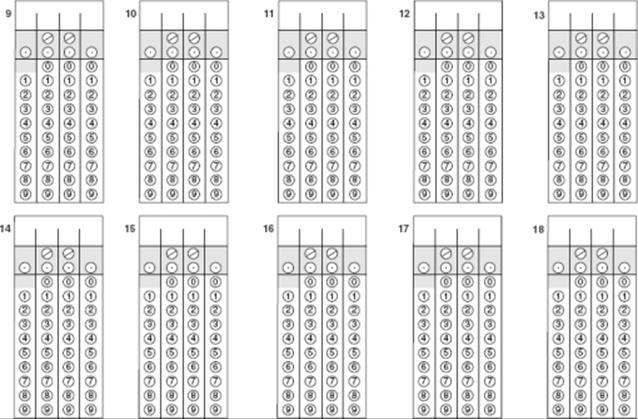
Section 8

Section 9

Section 10

Test 4
SECTION 1
Time—25 Minutes
ESSAY
The excerpt appearing below makes a point about a particular topic. Read the passage carefully, and think about the assignment that follows.
We most resent in others the very flaws that we ourselves possess.
ASSIGNMENT: What are your thoughts on the statement above? Do you agree or disagree with the writer’s assertion? Compose an essay in which you express your views on this topic. Your essay may support, refute, or qualify the view expressed in the statement. What you write, however, must be relevant to the topic under discussion. Additionally, you must support your viewpoint, indicating your reasoning and providing examples based on your studies and/or experience.
SECTION 2
Time—25 Minutes 24 Questions
Select the best answer to each of the following questions; then blacken the appropriate space on your answer sheet.
Each of the following sentences contains one or two blanks; each blank indicates that a word or set of words has been left out. Below the sentence are five words or phrases, lettered A through E. Select the word or set of words that best completes the sentence.
Example:
Fame is ----; today’s rising star is all too soon tomorrow’s washed-up has-been.
(A) rewarding
(B) gradual
(C) essential
(D) spontaneous
(E) transitory
![]()
1. He felt that the uninspiring routine of office work was too ---- for someone of his talent and creativity.
(A) diverse
(B) insatiable
(C) exacting
(D) enthralling
(E) prosaic
2. The museum arranged the fossils in ---- order, placing the older fossils dating from the Late Ice Age on the first floor and the more recent fossils on the second floor.
(A) alphabetical
(B) chronological
(C) random
(D) arbitrary
(E) retrospective
3. With the evolution of wings, insects were able to ---- to the far ecological corners, across deserts and bodies of water, to reach new food sources and inhabit a wider variety of promising environmental niches.
(A) relate
(B) disperse
(C) transgress
(D) revert
(E) ascend
4. Having recently missed out on the Matisse retrospective, which has taken Paris and New York by storm, and on the tour of great paintings from Philadelphia’s Barnes collection, London is becoming ---- in the competition to show ---- international art exhibitions.
(A) a trend-setter..major
(B) an also-ran..blockbuster
(C) a world-beater..itinerant
(D) a mecca..distinguished
(E) a connoisseur..esoteric
5. What most ---- the magazine’s critics is the manner in which its editorial opinions are expressed—too often as if only an idiot could see things any other way.
(A) belies
(B) impedes
(C) riles
(D) placates
(E) identifies
6. Despite her compassionate nature, the new nominee to the Supreme Court was single-minded and ---- in her strict ---- the letter of the law.
(A) merciful..interpretation of
(B) uncompromising..adherence to
(C) dilatory..affirmation of
(D) vindictive..deviation from
(E) lenient..dismissal of
7. Although he generally observed the adage “Look before you leap,” in this instance he was ---- acting in an unconsidered fashion.
(A) chary of
(B) impervious to
(C) precipitate in
(D) hesitant about
(E) conventional in
8. Crabeater seal, the common name of Lobodon car-cinophagus, is a ----, since the animal’s staple diet is not crabs, but krill.
(A) pseudonym
(B) misnomer
(C) delusion
(D) digression
(E) compromise
Read each of the passages below, and then answer the questions that follow the passage. The correct response may be stated outright or merely suggested in the passage.
Questions 9 and 10 are based on the following passage.
In the 1880’s, when the commercial theater
had ceased to be regarded as a fit medium for
serious writers, British intellectuals came to
champion the plays of an obscure Norwegian
Line (5) dramatist. Hungry for a theater that spoke to their
intellects, they wholeheartedly embraced the
social realist dramas of Henrik Ibsen. Eleanor
Marx, daughter of Karl Marx, went so far as to
teach herself Norwegian in order to translate
(10) Ibsen’s A Doll’s House, which she presented in
an amateur performance in a Bloomsbury drawing
room.
9. In line 6, “embraced” most nearly means
(A) clasped
(B) adopted
(C) comprised
(D) incorporated
(E) hugged
10. The discussion of Eleanor Marx in lines 7–12 (“Eleanor . . . room”) serves primarily to
(A) propose a counterexample
(B) correct an inaccurate statement
(C) introduce a questionable hypothesis
(D) support an earlier assertion
(E) acknowledge a factual discrepancy
Questions 11 and 12 are based on the following passage.
According to reports from psychologists worldwide,
measures of personal happiness hardly
change as the national income rises. This finding
has led many social critics to maintain that income
Line (5) growth has ceased to foster well-being. A moment’s
recollection suggests otherwise. I remember years
ago when our car clanked and juddered and limped
into a garage, warning lights ablaze. “Threw a
rod,” said the mechanic. “Junk her.” I remember
(10) interminable trips to used-car lots, sleepless nights
worrying about debt, calls to friends about possible
leads. Recently, my wife suggested we get a new
car. “Great!” I said. “What about a hybrid?”
Money can’t buy happiness, but having money
(15) sure takes the pressure off.
11. In lines 6–13, the author uses a personal anecdote to
(A) warn about the dangers of consumer debt
(B) explain what caused the author’s engine trouble
(C) suggest the range of the author’s tastes in automobiles
(D) express an unorthodox view about psychology
(E) contradict the social critics’ conclusion
12. The author’s tone in the closing lines of the passage (lines 14 and 15) can best be characterized as
(A) breezy
(B) objective
(C) cautionary
(D) ambivalent
(E) nostalgic
Questions 13–24 are based on the following passage.
The writer John Updike muses on the significance of Mickey Mouse.
Cartoon characters have soul as Carl Jung
defined it in his Archetypes and the Collective
Unconscious: “soul is a life-giving demon who
plays his elfin game above and below human
Line (5) existence.” Without the “leaping and twinkling of
the soul,” Jung says, “man would rot away in his
greatest passion, idleness.” The Mickey Mouse of
the thirties shorts was a whirlwind of activity,
with a host of unsuspected skills and a reluctant
(10) heroism that rose to every occasion. Like Chaplin
and Douglas Fairbanks and Fred Astaire, he acted
out our fantasies of endless nimbleness, of perfect
weightlessness. Yet withal, there was nothing
aggressive or self-promoting about him, as there
(15) was about Popeye. Disney, interviewed in the
thirties, said, “Sometimes I’ve tried to figure out
why Mickey appealed to the whole world.
Everybody’s tried to figure it out. So far as I
know, nobody has. He’s a pretty nice fellow who
(20) never does anybody any harm, who gets into
scrapes through no fault of his own, but always
manages to come up grinning.” This was perhaps
Disney’s image of himself: for twenty years he
did Mickey’s voice in the films, and would often
(25) say, “There’s a lot of the Mouse in me.” Mickey
was a character created with his own pen, and
nurtured on Disney’s memories of his mouse-ridden
Kansas City studio and of the Missouri farm
where his struggling father tried for a time to
(30) make a living. Walt’s humble, scrambling beginnings
remained embodied in the mouse, whom
the Nazis, in a fury against the Mickey-inspired
Allied legions (the Allied code word on D-Day
was “Mickey Mouse”), called “the most miserable
(35) ideal ever revealed...mice are dirty.”
But was Disney, like Mickey, just “a pretty
nice fellow”? He was until crossed in his driving
perfectionism, his Napoleonic capacity to marshal
men and take risks in the service of an artistic and
(40) entrepreneurial vision. He was one of those great
Americans, like Edison and Henry Ford, who
invented themselves in terms of a new technology.
The technology—in Disney’s case, film
animation—would have been there anyway, but
(45) only a few driven men seized the full possibilities
and made empires. In the dozen years between
Steamboat Willie and Fantasia, the Disney studios
took the art of animation to heights of ambition
and accomplishment it would never have
(50) reached otherwise, and Disney’s personal zeal
was the animating force. He created an empire of
the mind, and its emperor was Mickey Mouse.
The thirties were Mickey’s conquering decade.
His image circled the globe. In Africa, tribesmen
(55) painfully had tiny mosaic Mickey Mouses inset
into their front teeth, and a South African tribe
refused to buy soap unless the cakes were
embossed with Mickey’s image. Nor were the
high and mighty immune to Mickey’s elemental
(60) appeal—King George V and Franklin Roosevelt
insisted that all film showings they attended
include a dose of Mickey Mouse. But other popular
phantoms, like Felix the Cat, have faded,
where Mickey has settled into the national collective
(65) consciousness. The television program
revived him for my children’s generation, and the
theme parks make him live for my grandchildren’s.
Yet survival cannot be imposed through
weight of publicity. Mickey’s persistence springs
(70) from something unhyped, something timeless in
the image that has allowed it to pass in status
from a fad to an icon.
To take a bite out of our imaginations, an icon
must be simple. The ears, the wiggly tail, the red
(75) shorts, give us a Mickey. Donald Duck and
Goofy, Bugs Bunny and Woody Woodpecker are
inextricably bound up with the draftsmanship of
the artists who make them move and squawk, but
Mickey floats free. It was Claes Oldenburg’s pop
(80) art that first alerted me to the fact that Mickey
Mouse had passed out of the realm of commercially
generated image into that of artifact. A new
Disney gadget, advertised on television, is a
camera-like box that spouts bubbles when a key is
(85) turned; the key consists of three circles, two
mounted on a larger one, and the image is
unmistakably Mickey. Like yin and yang, like the
Christian cross and the star of Israel, Mickey can
be seen everywhere—a sign, a rune, a hieroglyphic
(90) trace of a secret power, an electricity we
want to plug into. Like totem poles, like African
masks, Mickey stands at that intersection of
abstraction and representation where magic
connects.
13. The author’s attitude toward Popeye in lines 13–15 is primarily
(A) nostalgic
(B) deprecatory
(C) apathetic
(D) vindictive
(E) reverent
14. By describing Mickey’s skills as “unsuspected” and his heroism as “reluctant” (line 9), the author primarily conveys Mickey’s
(A) unassuming nature
(B) unrealistic success
(C) contradictory image
(D) ignominious failings
(E) idealistic character
15. In line 21, “scrapes” most nearly means
(A) abrasions
(B) harsh sounds
(C) small economies
(D) discarded fragments
(E) predicaments
16. By saying “There’s a lot of the Mouse in me” (line 25), Disney revealed
(A) his inability to distinguish himself as an individual
(B) the extent of his identification with his creation
(C) the desire to capitalize on his character’s popularity
(D) his fear of being surpassed by a creature he produced
(E) his somewhat negative image of himself
17. The reference to the Nazis’ comments on Mickey (lines 32–35) can best be described as
(A) a digression
(B) a metaphor
(C) an analysis
(D) an equivocation
(E) a refutation
18. In line 37, “crossed” most nearly means
(A) traversed
(B) confused
(C) intersected
(D) encountered
(E) opposed
19. The author views Disney as all of the following EXCEPT
(A) a self-made man
(B) a demanding artist
(C) an enterprising businessman
(D) the inventor of film animation
(E) an empire-builder
20. The references to the African tribesmen (lines 54–58) and to Franklin Roosevelt (line 60) serve primarily to
(A) demonstrate the improbability of Mickey’s reaching such disparate audiences
(B) dispel a misconception about the nature of Mickey’s popularity
(C) support the assertion that people of all backgrounds were drawn to Mickey Mouse
(D) show how much research the author has done into the early history of Disney cartoons
(E) answer the charges made by critics of Disney’s appeal
21. The distinction made between a “fad” and an “icon” (lines 68–72) can best be summarized as which of the following?
(A) The first is a popular fashion, the second attracts only a small group.
(B) The first involves a greater degree of audience involvement than the second.
(C) The first is less likely to need publicity than the second.
(D) The first is less enduring in appeal than is the second.
(E) The first conveys greater prestige than the second.
22. In line 73, “take a bite out of our imaginations” most nearly means
(A) injure our creativity
(B) reduce our innovative capacity
(C) cut into our inspiration
(D) capture our fancies
(E) limit our visions
23. The author’s description of the new Disney gadget (lines 82–87) does which of the following?
(A) It suggests that popular new product lines are still being manufactured by Disney.
(B) It demonstrates that even a rudimentary outline can convey the image of Mickey.
(C) It illustrates the importance of television advertising in marketing new products.
(D) It disproves the notion that Disney’s death has undermined his mercantile empire.
(E) It refutes the author’s assertion that Mickey’s survival springs from something unhyped.
24. Which of the following most resembles the new Disney gadget (lines 82–87) in presenting Mickey as an artifact?
(A) A comic book presenting the adventures of Mickey Mouse
(B) A rubber mask realistically portraying Mickey’s features
(C) A Mickey Mouse watch on which Mickey’s hands point at the time
(D) A Mickey Mouse waffle iron that makes waffles in the shape of three linked circles
(E) A framed cell or single strip from an original Mickey Mouse animated film
S T O P
YOU MAY GO BACK AND REVIEW THIS SECTION IN THE REMAINING TIME, BUT DO NOT WORK IN ANY OTHER SECTION UNTIL TOLD TO DO SO.
SECTION 3
Time—25 Minutes 20 Questions
For each problem in this section determine which of the five choices is correct and blacken the corresponding choice on your answer sheet. You may use any blank space on the page for your work.
Notes:
• You may use a calculator whenever you think it will be helpful.
• Only real numbers are used. No question or answer on this test involves a complex or imaginary number.
• Use the diagrams provided to help you solve the problems. Unless you see the words “Note: Figure not drawn to scale” under a diagram, it has been drawn as accurately as possible. Unless it is stated that a figure is three-dimensional, you may assume it lies in a plane.
• For any function f, the domain, unless specifically restricted, is the set of all real numbers for which f (x) is also a real number.
Reference Information
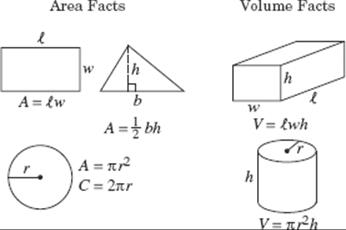
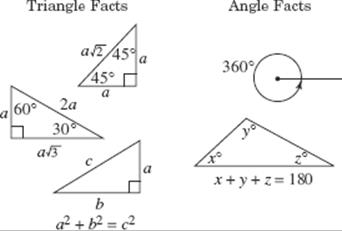
1. Which of the following numbers has the same digit in the hundreds and hundredths places?
(A) 2200.0022
(B) 2224.2442
(C) 2242.4242
(D) 2246.2462
(E) 2246.6422
2. Beth has twice as many baseball cards as Bruce. If Beth has b cards, how many cards does Bruce have?
(A) 2b
(B) b2
(C) ![]()
(D) ![]()
(E) b + 2
3. Alexis programmed her VCR to record for exactly 225 minutes. If it began recording at 9:05 A.M., at what time did it stop recording?
(A) 11:30 A.M.
(B) 12:00 P.M.
(C) 12:30 P.M.
(D) 12:50 P.M.
(E) 1:00 P.M.

4. In the figure above, what is the value of x?
(A) 40
(B) 60
(C) 70
(D) 80
(E) 140
5. If the difference of two numbers is greater than the sum of the numbers, which of the following must be true?
(A) Neither number is negative.
(B) At least one of the numbers is negative.
(C) Exactly one of the numbers is negative.
(D) Both numbers are negative.
(E) None of these statements must be true.
6. (3a2b3)3 =
(A) 9a5b6
(B) 9a6b9
(C) 27a5b6
(D) 27a6b9
(E) 27a8b27
7. Anne-Marie was x years old y years ago. How old will she be in z years?
(A) x + y + z
(B) x – y + z
(C) z – x – y
(D) y – x + z
(E) x – y – z
8. 10 is what percent of A?
(A) 10A%
(B) ![]()
(C) ![]()
(D) ![]()
(E) ![]()
9. A rectangle has a perimeter equal to the circumference of a circle of radius 3. If the width of the rectangle is 3, what is its length?
(A) 3![]() – 3
– 3
(B) 4.5![]() – 3
– 3
(C) 6![]() – 6
– 6
(D) 9![]() – 3
– 3
(E) 9![]() – 6
– 6
10. If Anthony had 3 times as many marbles as he actually has, he would have ![]() as many marbles as Billy has. What is the ratio of the number of marbles Anthony has to the number of marbles Billy has?
as many marbles as Billy has. What is the ratio of the number of marbles Anthony has to the number of marbles Billy has?
(A) 1:9
(B) 1:3
(C) 1:1
(D) 3:1
(E) 9:1
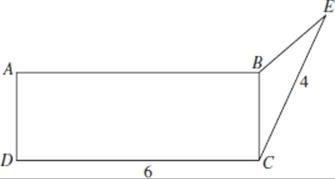
11. In the figure above, BC ![]() BE. If R represents the perimeter of rectangle ABCD, and T represents the perimeter of
BE. If R represents the perimeter of rectangle ABCD, and T represents the perimeter of ![]() CBE, what is the value of R – T?
CBE, what is the value of R – T?
(A) 2
(B) 8
(C) 20
(D) 12 – 4![]()
(E) It cannot be determined from the information given.
12. Two cylindrical tanks have the same height, but the radius of one tank equals the diameter of the other.
If the volume of the larger is k% more than the volume of the smaller, k =
(A) 50
(B) 100
(C) 200
(D) 300
(E) 400
13. For any positive numbers a, b, c, d, ![]() is defined to be a number box if ac = bd and a = b + c + d.
is defined to be a number box if ac = bd and a = b + c + d.
If ![]() is a number box, then x + y =
is a number box, then x + y =
(A) 8
(B) 10
(C) 12
(D) 14
(E) 24
14. If f(x) = 3x + 8, for what value of a is f(a) = a?
(A) –4
(B) –2
(C) ![]()
(D) 0
(E) ![]()
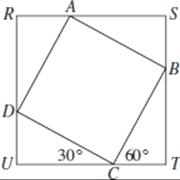
15. In the figure above, if the perimeter of square ABCD is 8, what is the perimeter of square RSTU?
(A) 4 + 4 ![]()
(B) 8 ![]()
(C) 12
(D) 16
(E) It cannot be determined from the information given.
16. If x + y = a, y + z = b, and x + z = c, what is the average (arithmetic mean) of x, y, and z?
(A) ![]()
(B) ![]()
(C) ![]()
(D) ![]()
(E) ![]()
17. A circular grass field has a circumference of 120 ![]() meters. If Eric can mow 400 square meters of grass per hour, how many hours will he take to mow the entire field?
meters. If Eric can mow 400 square meters of grass per hour, how many hours will he take to mow the entire field?
(A) 4
(B) 5
(C) 6
(D) 8
(E) 9
18. If ![]() what is the result on X of doubling a, tripling b, and quadrupling c?
what is the result on X of doubling a, tripling b, and quadrupling c?
(A) X is multiplied by 1.5.
(B) X is multiplied by 3.
(C) X is multiplied by 4.5.
(D) X is multiplied by 6.
(E) X is multiplied by 9.
19. A sequence of numbers begins 1, 1, 1, 2, 2, 3 and then repeats this pattern of six numbers forever. What is the sum of the 135th, 136th, and 137th numbers in the sequence?
(A) 3
(B) 4
(C) 5
(D) 6
(E) 7
20. The measures of the three angles of a triangle are in the ratio of 5:5:10, and the length of the longest side is 10. From this information, which of the following can be determined?
I. The area of the triangle
II. The perimeter of the triangle
III. The length of each of the three altitudes
(A) I only
(B) II only
(C) III only
(D) I and II only
(E) I, II, and III
S T O P
YOU MAY GO BACK AND REVIEW THIS SECTION IN THE REMAINING TIME, BUT DO NOT WORK IN ANY OTHER SECTION UNTIL TOLD TO DO SO.
SECTION 4
Time—25 Minutes 35 Questions
Select the best answer to each of the following questions; then blacken the appropriate space on your answer sheet.
Some or all parts of the following sentences are underlined. The first answer choice, (A), simply repeats the underlined part of the sentence. The other four choices present four alternative ways to phrase the underlined part. Select the answer that produces the most effective sentence, one that is clear and exact, and blacken the appropriate space on your answer sheet. In selecting your choice, be sure that it is standard written English, and that it expresses the meaning of the original sentence.
Example:
The first biography of author Eudora Welty came out in 1998 and she was 89 years old at the time.
(A) and she was 89 years old at the time
(B) at the time when she was 89
(C) upon becoming an 89 year old
(D) when she was 89
(E) at the age of 89 years old
![]()
1. Are psychiatrists unusually vulnerable to mental illness, or are they merely more aware of their problems than the rest of us?
(A) problems than the rest of us
(B) problems as us
(C) problems than they are aware of us
(D) problems like we are
(E) problems like ours are
2. When used undiluted, you can irritate your skin with liquid bleach.
(A) you can irritate your skin with liquid bleach
(B) liquid bleach can irritate your skin
(C) bleach, it being liquid, could irritate your skin
(D) you could be irritating your skin with liquid bleach
(E) then liquid bleach could be irritating to your skin
3. The authors, taking on a formidable and sensitive subject, has largely conquered it, thanks to indefatigable research and a rigorous analysis of the data.
(A) taking on a formidable and sensitive subject, has largely conquered it, thanks to indefatigable research
(B) took on a formidable and sensitive subject; but has largely conquered it, thanks to indefatigable research
(C) taking on a formidable and sensitive subject, have largely conquered it, thanks to indefatigable research
(D) taking on a formidable and sensitive subject, have largely conquered them, thanks to indefatigable research
(E) taking on a formidably sensitive subject, has largely conquered it, due to indefatigable research
4. Paul Bertolli followed a typically meandering route for a contemporary American chef, earning a degree in music at Berkeley, working in restaurants in California and Italy, and took time off to study history in Canada before becoming the chef at Oliveto.
(A) working in restaurants in California and Italy, and took time off to study history in Canada before becoming
(B) working in restaurants in California and Italy, and taking time off to study history in Canada before becoming
(C) and he worked in restaurants in California and Italy, and took time off to study history in Canada before becoming
(D) working in restaurants in California and Italy, and took time off to study history in Canada before he had become
(E) he worked in restaurants in California and Italy, and he took time off to study history in Canada before becoming
5. Many of the innovations in the early compositions of Charles Ives were adaptations of musical experiments performed by his father, particularly that of polytonality.
(A) Ives were adaptations of musical experiments performed by his father, particularly that of polytonality
(B) Ives, and in particular polytonality, was an adaptation of musical experiments performed by his father
(C) Ives being adapted, and polytonality in particular, from musical experiments performed by his father
(D) Ives, these were adaptations of musical experiments performed by his father, particularly that of polytonality
(E) Ives, particularly polytonality, were adaptations of musical experiments performed by his father
6. Having exceptional talent in fencing, ballet, as well as debate, Benjamin was considered to be a likely candidate for admission to Harvard.
(A) Having exceptional talent in fencing, ballet, as well as debate
(B) Because of his exceptional talent in fencing, ballet, and debate
(C) Having exceptional talent in fencing, ballet, and in debate as well
(D) By being an exceptional talent in both fencing and ballet, and also debate
(E) With his exceptional talent in fencing and ballet and being good in debating
7. Of the three Fates, the weavers Clotho, Lachesis, and Atropos, the latter was most frightening, for she cut the “thread” of life, thus determining the individual’s moment of death.
(A) the latter was most frightening
(B) the latter was more frightening
(C) the latter is most frightening
(D) the last was most frightening
(E) the last are more frightening
8. A popular lecturer who spoke as eloquently on Christianity as literature, Lewis combined faith and fiction in his allegorical tales of Narnia.
(A) as eloquently on Christianity as literature
(B) with eloquence on Christianity and literature also
(C) eloquently on Christianity so much as on literature
(D) so eloquently on Christianity plus literature
(E) as eloquently on Christianity as on literature
9. Administration officials have consistently sought to stonewall, undermine, or intimidating anyone who might try to check up on their performance.
(A) undermine, or intimidating anyone who might try to check up on their performance
(B) undermine, or intimidating those who might try to check up on their performance
(C) undermine, or intimidating anyone who might try to check up about their performance
(D) undermine, or intimidate anyone who might try to check up on their performance
(E) undermine, or to be intimidating anyone who might be trying to check up on their performance
10. Although I understand why airlines have to serve frozen foods to their passengers, I do not understand why I was served a meal by a flight attendant that had been only partially defrosted.
(A) a meal by a flight attendant that had been only partially defrosted
(B) an only partially defrosted meal by a flight attendant
(C) a meal that had been only partially defrosted by a flight attendant
(D) by a flight attendant a meal that had been only partially defrosted
(E) by a flight attendant of a partially defrosted meal
11. An important factor in the spread of disease is when people fail to practice proper hygiene.
(A) An important factor in the spread of disease is when
(B) An important factor in spreading disease is when
(C) An important factor in the spread of disease is that
(D) Much of the spread of disease results from when
(E) Much of the spread of disease is due to the fact that when
The sentences in this section may contain errors in grammar, usage, choice of words, or idioms. Either there is just one error in a sentence or the sentence is correct. Some words or phrases are underlined and lettered; everything else in the sentence is correct.
If an underlined word or phrase is incorrect, choose that letter; if the sentence is correct, select No error. Then blacken the appropriate space on your answer sheet.
Example:
The region has a climate ![]() plants
plants ![]() rarely
rarely ![]() more than twelve inches
more than twelve inches ![]()
![]()
![]()
12. ![]() of the danger, the
of the danger, the ![]() soldiers of the Light Brigade obeyed the orders of
soldiers of the Light Brigade obeyed the orders of ![]() commander and
commander and ![]() the enemy forces.
the enemy forces. ![]()
13. The President ![]() Senator Frank
Senator Frank ![]() one of the Congressmen who
one of the Congressmen who ![]() to attend the conference
to attend the conference ![]() nuclear waste disposal.
nuclear waste disposal. ![]()
14. In American history, we studied ![]() the American colonists
the American colonists ![]() oppose the British, the
oppose the British, the ![]() the Continental Congress,
the Continental Congress, ![]()
![]()
15. The fire officials ![]() the high casualty rate to the fact that not one of the
the high casualty rate to the fact that not one of the ![]() two thousand rooms in the hotel
two thousand rooms in the hotel ![]() with sprinklers
with sprinklers ![]() smoke detectors.
smoke detectors. ![]()
16. The students in the audience ![]() restive and noisy
restive and noisy ![]() the curtain failed to
the curtain failed to ![]() at the
at the ![]() time.
time. ![]()
17. There ![]() progress in the biological sciences since Crick and Watson
progress in the biological sciences since Crick and Watson ![]() discovered the
discovered the ![]() DNA.
DNA. ![]()
18. If one follows the discipline of Hatha Yoga, ![]() the
the ![]() importance of purificatory processes, the regulation of breathing, and the
importance of purificatory processes, the regulation of breathing, and the ![]() certain
certain ![]() postures, such as the lotus position.
postures, such as the lotus position. ![]()
19. Oprah Winfrey ![]() the
the ![]() having promoted the sales
having promoted the sales ![]() serious contemporary novels than
serious contemporary novels than ![]() talk show host.
talk show host. ![]()
20. The new inspector general’s office in Iraq ![]() rules that
rules that ![]() both its powers and
both its powers and ![]() independence.
independence. ![]()
21. Chinese scientists analyzing the genome of the SARS virus ![]() the immense rapidity
the immense rapidity ![]() it
it ![]() an animal pathogen into one
an animal pathogen into one ![]() infecting human cells.
infecting human cells. ![]()
22. Also in the program ![]() a taped
a taped ![]() the
the ![]() choreographer George Balanchine and a
choreographer George Balanchine and a ![]() Patricia McBride and Edward Villella of the pas de deux from “Diana and Acteon.”
Patricia McBride and Edward Villella of the pas de deux from “Diana and Acteon.” ![]()
23. Fifty years ago, movies ![]() biblical themes,
biblical themes, ![]() the
the![]() controversial Hollywood offerings,
controversial Hollywood offerings,![]() the least.
the least. ![]()
24. The Bronte Myth, Lucasta Miller’s study of the three British novelists, ![]() to trace the historical route
to trace the historical route ![]() Charlotte and Emily Bronte (and,
Charlotte and Emily Bronte (and, ![]() Anne) became
Anne) became ![]() cultural icons.
cultural icons. ![]()
25. Religion ![]()
![]() and politics, one of those subjects traditionally
and politics, one of those subjects traditionally ![]() at dinner parties or family reunions,
at dinner parties or family reunions,![]() inflamed passions disrupt civility.
inflamed passions disrupt civility. ![]()
26. Opinions on Charles Ives as a composer ![]() with some listeners regarding him as,
with some listeners regarding him as, ![]() an entertaining eccentric,
an entertaining eccentric, ![]() others lauding him as the
others lauding him as the ![]() composer of his age.
composer of his age. ![]()
27. Reviewing the ballet, the Times dance critic expressed her ![]() Damian Woetzel’s
Damian Woetzel’s ![]() performance, which, she wrote, was
performance, which, she wrote, was ![]()
![]()
![]()
28. The annual guest lecture, originally ![]() fall semester, is
fall semester, is ![]()
![]() until spring because of the visiting lecturer’s
until spring because of the visiting lecturer’s ![]() illness.
illness. ![]()
29. In the nineteenth century, photography was a ![]() the world for curious members of the public,
the world for curious members of the public, ![]()
![]() to visit exotic lands
to visit exotic lands ![]()
![]()
The passage below is the unedited draft of a student’s essay. Parts of the essay need to be rewritten to make the meaning clearer and more precise. Read the essay carefully.
The essay is followed by six questions about changes that might improve all or part of the organization, development, sentence structure, use of language, appropriateness to the audience, or use of standard written English. In each case, choose the answer that most clearly and effectively expresses the student’s intended meaning. Indicate your choice by blackening the corresponding space on the answer sheet.
[1] At the beginning of the twentieth century, no one knew the technological developments that would be made by the 1990s. [2] The area of communication media is one of the significant developments in the twentieth century. [3] Also nuclear energy and great advancements in medicine and the treatment of disease.
[4] One important development was the invention of communication satellites which allow images and messages to be sent wirelessly around the world. [5] One advantage is that current events can be sent worldwide in seconds. [6] News used to travel by boat and take weeks or months to get overseas. [7] When a disaster struck the World Trade Center, the world saw it immediately and condemned the terrorists’ actions. [8] One weak aspect of communication satellites is that they are launched from a space shuttle, and that is an extremely costly operation. [9] They also cost millions of dollars to build and operate. [10] Therefore, many poor countries are left out of the so-called “Global Village.”
[11] The invention and use of nuclear energy is another important technological development. [12] One positive feature of nuclear energy is that energy is cheaper, and can be made easy. [13] This is important in countries like France where almost all of the electricity is nuclear. [14] A negative consequence of nuclear energy is the probability of major nuclear accidents. [15] Watch out for human error and careless workmanship. [16] They were the cause of the meltdown in Chernobyl, which killed hundreds or maybe even thousands, and radiated half the Earth.
[17] There have been many significant technological advances in medicine in the twentieth century. [18] One development was the invention of the CAT scan. [19] The CAT scan allows doctors to make a picture of your brain to see if there is a growth on it. [20] One positive effect of the CAT scan is that doctors can diagnose brain tumors and brain cancer at an early stage. [21] One negative effect is that CAT scans are costly, so they are not used in third world countries.
30. In view of the main idea of the whole essay, which of the following is the best revision of sentence 1?
(A) In 1900 no one could anticipate the technological developments in the 1990s.
(B) Recent technological achievements would blow the minds of people at the beginning of the twentieth century.
(C) The twentieth century has seen remarkable technological achievements, but there has also been a price to pay for progress.
(D) No one knows if the twenty-first century will produce as much technological progress as the twentieth century did.
(E) Technological progress in communications, nuclear energy, and medicine is wonderful, but in the process we are destroying ourselves and our environment.
31. Which is the best revision of the underlined segment of sentence 12 below?
One positive feature of nuclear energy is that energy is cheaper, and can be made easy.
(A) energy is cheaper and can be made easily
(B) energy is made cheaper and more easily made
(C) it is cheap and easy to make
(D) it is both cheap as well as made easily
(E) it’s more cheaper and easier to make
32. To improve the coherence of paragraph 2, which of the following is the best sentence to delete from the essay?
(A) Sentence 5
(B) Sentence 6
(C) Sentence 7
(D) Sentence 8
(E) Sentence 9
33. In the context of the sentences that precede and follow sentence 15, which is the best revision of sentence 15?
(A) Human error and careless workmanship are almost unavoidable.
(B) Especially human error and careless workmanship.
(C) There’s hardly no foolproof way to prevent human error and careless workmanship.
(D) You must never put down your guard against human error and careless workmanship.
(E) Accidents can happen accidentally by human error and careless workmanship.
34. With regard to the entire essay, which of the following best explains the writer’s intention in paragraphs 2, 3, and 4?
(A) To compare and contrast three technological achievements
(B) To provide examples of the pros and cons of technological progress
(C) To analyze the steps needed for achievement in three areas
(D) To convince the reader to be open to technological change
(E) To advocate more funds for technological research and development
35. Assume that sentences 17 and 18 were combined as follows: A significant advance in medicine has been the invention of the CAT scan. Which of the following is the best way to continue the paragraph?
(A) The CAT scan allows your doctors to make pictures of a brain to see if it has a growth on it, a cancer is growing, or tumors at an early stage.
(B) The CAT scan permits your doctors to make a picture and see if your brain has a growth on it, or whether or not you have brain tumors or brain cancer at an early stage.
(C) Taking pictures with a CAT scan, your brain is studied by doctors for growths, brain tumors, and cancer at an early stage.
(D) Doctors may make pictures of your brain to see if there is a growth, a tumor, or cancer at an early stage on it.
(E) With this device a doctor may look into a patient’s brain to check for growths and to detect cancerous tumors at an early stage.
S T O P
YOU MAY GO BACK AND REVIEW THIS SECTION IN THE REMAINING TIME, BUT DO NOT WORK IN ANY OTHER SECTION UNTIL TOLD TO DO SO.
SECTION 6
Time—25 Minutes 24 Questions
Select the best answer to each of the following questions; then blacken the appropriate space on your answer sheet.
Each of the following sentences contains one or two blanks; each blank indicates that a word or set of words has been left out. Below the sentence are five words or phrases, lettered A through E. Select the word or set of words that best completes the sentence.
Example:
Fame is ----; today’s rising star is all too soon tomorrow’s washed-up has-been.
(A) rewarding
(B) gradual
(C) essential
(D) spontaneous
(E) transitory
![]()
1. She pointed out that his resume was ---- because it merely recorded his previous positions and failed to highlight the specific skills he had mastered in each job.
(A) disinterested
(B) inadequate
(C) conclusive
(D) obligatory
(E) detailed
2. Because it was already known that retroviruses could cause cancer in animals, it seemed only ---- to search for similar cancer-causing viruses in human beings.
(A) culpable
(B) charitable
(C) hypothetical
(D) logical
(E) negligent
3. Ms. Ono ---- gives interviews because she believes the news media have ---- her and treated her badly.
(A) frequently..publicized
(B) rarely..misrepresented
(C) seldom..eulogized
(D) reluctantly..acclaimed
(E) gradually..evaded
4. Totem craftsmanship reached its ---- in the nineteenth century, when the introduction of metal tools enabled carvers to execute more sophisticated designs.
(A) roots
(B) conclusion
(C) antithesis
(D) reward
(E) apex
5. For those who admire realism, Louis Malle’s recent film succeeds because it consciously ---- the stuff of legend and tells ---- story as it might actually unfold with fallible people in earthly time.
(A) rejects..a derivative
(B) anticipates..an antiquated
(C) shuns..an unembellished
(D) emulates..an ethereal
(E) exaggerates..a mythic
Read the passages below, and then answer the questions that follow them. The correct response may be stated outright or merely suggested in the passages.
Questions 6–9 are based on the following passages.
Passage 1
Exquisitely adapted for life in one of Earth’s
harshest environments, polar bears can survive for
20 years or more on the Arctic Circle’s glacial
ice. At home in a waste where temperatures reach
Line (5) minus 50 degrees Fahrenheit, these largest members
of the bear family are a striking example of
natural selection at work. With two layers of fur
over a subcutaneous layer of blubber, polar bears
are well adapted to resist heat loss. Their broad,
(10) snowshoe-like paws and sharp, curved claws
enable them to traverse the ice with ease.
Formidable hunters, these monarchs of the icy
waste even possess the capacity to scent prey
from a distance of 20 miles.
Passage 2
(15) Top predator of the arctic ecosystem, the polar
bear preys on beluga whales, narwhals, musk
oxen, walruses, hares, geese, and seals. In the
mid-twentieth century this fearsome killer became
the prey of even more deadly killers, trophy
(20) hunters and commercial hide hunters who came
close to decimating the polar bear population. For
a time, the 1973 signing of the international Polar
Bear Agreement, which prohibited the capture
and killing of polar bears and protected their habitats,
(25) reduced the danger of polar bear extinction.
Today, however, polar bears face a new threat, as
increasing arctic pollution fouls their environment
with chemical toxins.
6. In line 13, “capacity” most nearly means
(A) ability
(B) stature
(C) quantity
(D) spaciousness
(E) intelligence
7. Unlike Passage 2, Passage 1 is concerned primarily with the
(A) harsh living conditions in the Arctic Circle
(B) polar bear’s effect on its environment
(C) increasing decline of the polar bear population
(D) physical characteristics of polar bears
(E) mechanics of natural selection
8. Unlike the author of Passage 1, the author of Passage 2 does which of the following?
(A) proposes a solution
(B) explains a study
(C) quotes an authority
(D) poses a question
(E) establishes a time frame
9. Which generalization about polar bears is supported by both passages?
(A) They are vulnerable to chemical toxins.
(B) They are well adapted to a changing environment.
(C) They are notable predators.
(D) They move at a rapid rate.
(E) They are threatened by other predators.
Questions 10–15 are based on the following passage.
The following passage is taken from Jane Austen’s novel Persuasion. In this excerpt we meet Sir Walter Elliot, father of the heroine.
Vanity was the beginning and end of Sir
Walter Elliot’s character: vanity of person and of
situation. He had been remarkably handsome in
his youth, and at fifty-four was still a very fine
Line (5) man. Few women could think more of their personal
appearance than he did, nor could the valet
of any new-made lord be more delighted with the
place he held in society. He considered the blessing
of beauty as inferior only to the blessing of a
(10) baronetcy; and the Sir Walter Elliot, who united
these gifts, was the constant object of his warmest
respect and devotion.
His good looks and his rank had one fair claim
on his attachment, since to them he must have
(15) owed a wife of very superior character to
anything deserved by his own. Lady Elliot had been
an excellent woman, sensible and amiable, whose
judgment and conduct, if they might be pardoned
the youthful infatuation which made her Lady
(20) Elliot, had never required indulgence afterwards.
She had humored, or softened, or concealed his
failings, and promoted his real respectability for
seventeen years; and though not the very happiest
being in the world herself, had found enough in
(25) her duties, her friends, and her children, to attach
her to life, and make it no matter of indifference
to her when she was called on to quit them. Three
girls, the two eldest sixteen and fourteen, was an
awful legacy for a mother to bequeath, an awful
(30) charge rather, to confide to the authority and
guidance of a conceited, silly father. She had,
however, one very intimate friend, a sensible,
deserving woman, who had been brought, by
strong attachment to herself, to settle close by her,
(35) in the village of Kellynch; and on her kindness
and advice Lady Elliot mainly relied for the best
help and maintenance of the good principles and
instruction which she had been anxiously giving
her daughters.
(40) This friend and Sir Walter did not marry,
whatever might have been anticipated on that
head by their acquaintance. Thirteen years had
passed away since Lady Elliot’s death, and they
were still near neighbors and intimate friends, and
(45) one remained a widower, the other a widow.
That Lady Russell, of steady age and character,
and extremely well provided for, should have
no thought of a second marriage, needs no
apology to the public, which is rather apt to be
(50) unreasonably discontented when a woman does marry
again, than when she does not; but Sir Walter’s
continuing in singleness requires explanation. Be
it known, then, that Sir Walter, like a good father
(having met with one or two disappointments in
(55) very unreasonable applications), prided himself
on remaining single for his dear daughters’ sake.
10. According to the passage, Sir Walter Elliot’s vanity centered on his
I. physical attractiveness
II. possession of a title
III. superiority of character
(A) I only
(B) II only
(C) I and II
(D) I and III
(E) I, II, and III
11. The narrator speaks well of Lady Elliot for all of the following EXCEPT
(A) her concealment of Sir Walter’s shortcomings
(B) her choice of an intimate friend
(C) her guidance of her three daughters
(D) her judgment in falling in love with Sir Walter
(E) her performance of her wifely duties
12. It can be inferred that over the years Lady Elliot was less than happy because of
(A) her lack of personal beauty
(B) her separation from her most intimate friend
(C) the disparity between her character and that of her husband
(D) the inferiority of her place in society
(E) her inability to teach good principles to her wayward daughters
13. Lady Elliot’s emotions regarding her approaching death were complicated by her
(A) pious submissiveness to her fate
(B) anxieties over her daughters’ prospects
(C) resentment of her husband’s potential remarriage
(D) lack of feeling for her conceited husband
(E) reluctance to face the realities of her situation
14. The phrase “make it no matter of indifference to her when she was called on to quit them” (lines 26 and 27) is an example of
(A) ironic understatement
(B) effusive sentiment
(C) metaphorical expression
(D) personification
(E) parable
15. The “applications” made by Sir Walter (line 55) were most likely
(A) professional
(B) insincere
(C) marital
(D) mournful
(E) fatherly
Questions 16–24 are based on the following passage.
The following passage is excerpted from a text on Native American history. Here, the author describes how certain major Indian nations related to the European powers during the 1700s.
By the end of the seventeenth century the
coastal tribes along most of the Atlantic seaboard
had been destroyed, dispersed, or subjected
directly to European control. Yet the interior
Line (5) tribes—particularly those who had grouped themselves
into confederations—remained powers
(and were usually styled nations) who dealt with
Europeans on a rough plane of equality.
Throughout the eighteenth century, the Creeks,
(10) Choctaws, Chickasaws, Cherokees, and Iroquois,
as well as the tribes of the Old Northwest, alternately
made war and peace with the various
European powers, entered into treaties of alliance
and friendship, and sometimes made cessions of
(15) territory as a result of defeat in war. As the imperial
power of France and Great Britain expanded
into the interior, those powerful Indian nations
were forced to seek new orientations in their policy.
For each Indian nation the reorientation was
(20) different, yet each was powerfully affected by the
growth of European settlements, population, and
military power. The history of the reorientation of
Iroquois policy toward the Europeans may serve
as an example of the process that all the interior
(25) nations experienced in the eighteenth century.
The stability that had marked the Iroquois
Confederacy’s generally pro-British position was
shattered with the overthrow of James II in 1688,
the colonial uprisings that followed in Massachusetts,
(30) New York, and Maryland, and the commencement
of King William’s War against Louis XIV
of France. The increasing French threat to
English hegemony in the interior of North
America was signalized by French-led or French-inspired
(35) attacks on the Iroquois and on outlying
colonial settlements in New York and New
England. The high point of the Iroquois response
was the spectacular raid of August 5, 1689, in
which the Iroquois virtually wiped out the French
(40) village of Lachine, just outside Montreal. A
counterraid by the French on the English village of
Schenectady in March, 1690, instilled an
appropriate measure of fear among the English
and their Iroquois allies.
(45) The Iroquois position at the end of the war,
which was formalized by treaties made during the
summer of 1701 with the British and the French,
and which was maintained throughout most of the
eighteenth century, was one of “aggressive neutrality”
(50) between the two competing European
powers. Under the new system the Iroquois
initiated a peace policy toward the “far Indians,”
tightened their control over the nearby tribes, and
induced both English and French to support their
(55) neutrality toward the European powers by
appropriate gifts and concessions.
By holding the balance of power in the
sparsely settled borderlands between English and
French settlements, and by their willingness to
(60) use their power against one or the other nation if
not appropriately treated, the Iroquois played the
game of European power politics with effectiveness.
The system broke down, however, after the
French became convinced that the Iroquois were
(65) compromising the system in favor of the English
and launched a full-scale attempt to establish
French physical and juridical presence in the Ohio
Valley, the heart of the borderlands long claimed
by the Iroquois. As a consequence of the ensuing
(70) Great War for Empire, in which Iroquois neutrality
was dissolved and European influence moved
closer, the play-off system lost its efficacy and
a system of direct bargaining supplanted it.
16. The author’s primary purpose in this passage is to
(A) denounce the imperialistic policies of the French
(B) disprove the charges of barbarism made against the Indian nations
(C) expose the French government’s exploitation of the Iroquois balance of power
(D) describe and assess the effect of European military power on the policy of an Indian nation
(E) show the inability of the Iroquois to engage in European-style diplomacy
17. In line 7, “styled” most nearly means
(A) arranged
(B) designated
(C) brought into conformity with
(D) dismissed as
(E) made fashionable
18. In writing that certain of the interior tribes “dealt with Europeans on a rough plane of equality” (lines 7 and 8), the author
(A) agrees that the Europeans treated the Indians with unnecessary roughness
(B) concedes that the Indians were demonstrably superior to the Europeans
(C) acknowledges that European-Indian relations were not those of absolute equals
(D) emphasizes that the Europeans wished to treat the Indians equitably
(E) suggests that the coastal tribes lacked essential diplomatic skills
19. The author most likely has chosen to discuss the experience of the Iroquois because he regards it as
(A) singular
(B) colorful
(C) representative
(D) ephemeral
(E) obscure
20. It can be inferred from the passage that the author’s attitude toward the Iroquois leadership can best be described as one of
(A) suspicion of their motives
(B) respect for their competence
(C) indifference to their fate
(D) dislike of their savagery
(E) pride in their heritage
21. With which of the following statements would the author be LEAST likely to agree?
(A) The Iroquois were able to respond effectively to French acts of aggression.
(B) James II’s removal from the throne caused dissension to break out among the colonies.
(C) The French begrudged the British their alleged high standing among the Iroquois.
(D) Iroquois negotiations involved playing one side against the other.
(E) The Iroquois ceased to hold the balance of power early in the eighteenth century.
22. The author attributes such success as the Iroquois policy of aggressive neutrality had to
(A) the readiness of the Iroquois to fight either side
(B) the Iroquois’ ties of loyalty to the British
(C) French physical presence in the borderlands
(D) the confusion of the European forces
(E) European reliance on formal treaties
23. In line 65, “compromising” most nearly means
(A) humiliating
(B) jeopardizing
(C) revealing
(D) yielding
(E) conceding
24. The final three paragraphs of the passage provide
(A) an instance of a state of relationships described earlier
(B) a modification of a thesis presented earlier
(C) a refutation of an argument made earlier
(D) a summary of the situation referred to earlier
(E) an allusion to the state of events depicted earlier
S T O P
YOU MAY GO BACK AND REVIEW THIS SECTION IN THE REMAINING TIME, BUT DO NOT WORK IN ANY OTHER SECTION UNTIL TOLD TO DO SO.
SECTION 7
Time—25 Minutes 18 Questions 7
You have 25 minutes to answer the 8 multiple-choice questions and 10 student-produced response questions in this section.
For each multiple-choice question, determine which of the five choices is correct and blacken the corresponding choice on your answer sheet. You may use any blank space on the page for your work.
Notes:
• You may use
• You may use a calculator whenever you think it will be helpful.
• Only real numbers are used. No question or answer on this test involves a complex or imaginary number.
• Use the diagrams provided to help you solve the problems. Unless you see the words “Note: Figure not drawn to scale” under a diagram, it has been drawn as accurately as possible.Unless it is stated that a figure is three-dimensional, you may assume it lies in a plane.
• For any function f, the domain, unless specifically restricted, is the set of all real numbers for which f (x) is also a real number.
Reference Information


1. If A is the set of odd positive integers less than 10, and B is the set of prime numbers less than 10, how many positive integers less than 10 are in neither set A nor set B?
(A) 1
(B) 2
(C) 3
(D) 4
(E) 5
2. Mr. Gomes wrote a number on the blackboard. When he added 3 to the number, he got the same result as when he multiplied the number by 3. What was the number he wrote?
(A) –3
(B) 0
(C) 1.5
(D) ![]()
(E) 3
3. What positive number n satisfies the equation (16)(16)(16)n = ![]()
(A) ![]()
(B) 1
(C) 4
(D) 8
(E) 16
4. If A (2, –1) and B (4, 7) are the endpoints of a diameter of a circle, what is the area of the circle?
(A) 16![]()
(B) 17![]()
(C) 18![]()
(D) 144![]()
(E) 1156![]()

AB = BC = CD
Note: Figure not drawn to scale.
5. In the figure above, arcs ![]() and
and ![]() are semicircles. If a point is chosen at random inside the figure, what is the probability that the point lies in the shaded region?
are semicircles. If a point is chosen at random inside the figure, what is the probability that the point lies in the shaded region?
(A) ![]()
(B) ![]()
(C) ![]()
(D) ![]()
(E) ![]()
6. If r and s are positive numbers satisfying the inequality ![]() which of the following must be true?
which of the following must be true?
(A) ![]()
(B) ![]()
(C) ![]()
(D ![]()
(E) r and s can be any numbers as long as r ≠ s.
7. If f (x) = 3 + ![]() , which of the following CANNOT be a value of f (x)?
, which of the following CANNOT be a value of f (x)?
(A) ![]()
(B) ![]()
(C) 0
(D) ![]()
(E) 3
8. A square and an equilateral triangle each have sides of length 5. What is the ratio of the area of the square to the area of the triangle?
(A) ![]()
(B) ![]()
(C) ![]()
(D) ![]()
(D) ![]()
Directions for Student-Produced Response Questions (Grid-ins)
In questions 9–18, first solve the problem, and then enter your answer on the grid provided on the answer sheet. The instructions for entering your answers are as follows:
• First, write your answer in the boxes at the top of the grid.
• Second, grid your answer in the columns below the boxes.
• Use the fraction bar in the first row or the decimal point in the second row to enter fractions and decimal answers.
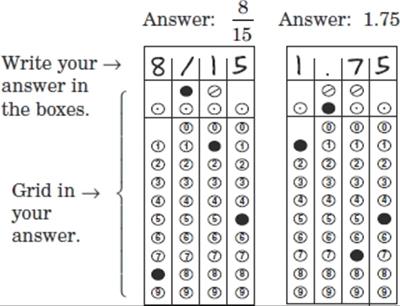
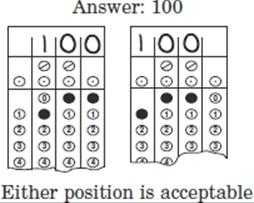
• Grid only one space in each column.
• Entering the answer in the boxes is recommended as an aid in gridding, but is not required.
• The machine scoring your exam can read only what you grid, so you must grid in your answers correctly to get credit.
• If a question has more than one correct answer, grid in only one of these answers.
• The grid does not have a minus sign, so no answer can be negative.
• A mixed number must be converted to an improper fraction or a decimal before it is gridded. Enter ![]() as 5/4 or 1.25; the machine will interpret 1 1/4 as
as 5/4 or 1.25; the machine will interpret 1 1/4 as ![]() and mark it wrong.
and mark it wrong.
• All decimals must be entered as accurately as possible. Here are the three acceptable ways of gridding
![]() = 0.272727........
= 0.272727........
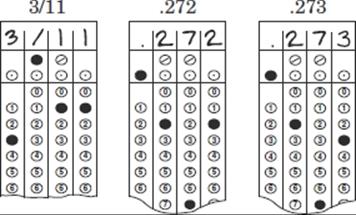
• Note that rounding to .273 is acceptable, because you are using the full grid, but you would receive no credit for .3 or .27, because these answers are less accurate.
9. Two white cards each measuring 3" × 5" are placed on a 9" × 12" piece of red construction paper so that they do not overlap. What is the area, in square inches, of the uncovered part of the red paper?
10. If 80% of the adult population of a village are registered to vote, and 60% of those registered actually voted in a particular election, what percent of the adults in the village did NOT vote in that election?
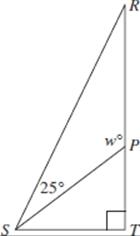
11. In the figure above, if PS bisects ![]() RST, what is the value of w?
RST, what is the value of w?
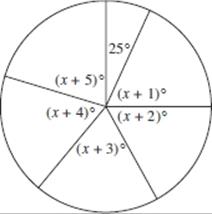
12. What is the value of x in the figure above?
13. If Henry drove 198 kilometers between 10:00 A.M. and 1:40 P.M., what was his average speed, in kilometers per hour?
14. The first term of a sequence is 1. Starting with the second term, each term is 1 less than 3 times the preceding term. What is the smallest number greater than 100 in the sequence?
15. Each stockholder of XYZ Corporation belongs to either Group A or Group B. Exactly 10% of the stockholders are in Group A, and collectively they own 80% of the stock. Let a represent the average number of shares of stock owned by the members of Group A, and b represent the average number of shares of stock owned by the members of Group B. If a = kb, what is the value of k?
16. In a jar containing only red and blue marbles, 40% of the marbles are red. If the average weight of a red marble is 40 grams and the average weight of a blue marble is 60 grams, what is the average weight, in grams, of all the marbles in the jar?
17. A school group charters three identical buses and occupies ![]() of the seats. After
of the seats. After ![]() of the passengers leave, the remaining passengers use only two of the buses. What fraction of the seats on the two buses are now occupied?
of the passengers leave, the remaining passengers use only two of the buses. What fraction of the seats on the two buses are now occupied?
18. If a4 = 16, then (2a)![]()
S T O P
YOU MAY GO BACK AND REVIEW THIS SECTION IN THE REMAINING TIME, BUT DO NOT WORK IN ANY OTHER SECTION UNTIL TOLD TO DO SO.
SECTION 8
Time—20 Minutes 19 Questions
Select the best answer to each of the following questions; then blacken the appropriate space on your answer sheet.
Each of the following sentences contains one or two blanks; each blank indicates that a word or set of words has been left out. Below the sentence are five words or phrases, lettered A through E. Select the word or set of words that best completes the sentence.
Example:
Fame is ----; today’s rising star is all too soon tomorrow’s washed-up has-been.
(A) rewarding
(B) gradual
(C) essential
(D) spontaneous
(E) transitory
![]()
1. Her ---- is always a source of irritation: she never uses a single word when she can substitute a long clause or phrase in its place.
(A) frivolity
(B) verbosity
(C) ambivalence
(D) cogency
(E) rhetoric
2. It is ---- to try to destroy pests completely with chemical poisons, for as each new chemical pesticide is introduced, the insects gradually become ---- to it.
(A) useless..drawn
(B) pointless..vulnerable
(C) futile..resistant
(D) wicked..indifferent
(E) worthwhile..immune
3. As delicate and ---- as insect bodies are, it is remarkable that over the ages enough of them have ----, preserved in amber, for scientists to trace insect evolution.
(A) beautiful..disappeared
(B) fragile..survived
(C) impervious..multiplied
(D) refined..awakened
(E) indestructible..evolved
4. Unfortunately, the current Broadway season offers some ---- fare that sounds markedly like imitations of previous hits.
(A) epic
(B) radical
(C) formulaic
(D) incongruous
(E) challenging
5. Surrounded by a retinue of sycophants who invariably ---- her singing, Callas wearied of the constant adulation and longed for honest criticism.
(A) orchestrated
(B) thwarted
(C) assailed
(D) extolled
(E) reciprocated
6. There is nothing ---- or provisional about Moore’s early critical pronouncements; she deals ---- with what were then radical new developments in poetry.
(A) tentative..confidently
(B) positive..expertly
(C) dogmatic..arbitrarily
(D) shallow..superficially
(E) imprecise..inconclusively
The questions that follow the next two passages relate to the content of both, and to their relationship. The correct response may be stated outright in the passage or merely suggested.
Questions 7–19 are based on the following passages.
The following passages are excerpted from popular articles on dolphins, the first dating from the 1960s, the second written in 1990.
Passage 1
Most of the intelligent land animals have
prehensile, grasping organs for exploring their
environment—hands in human beings and their
anthropoid relatives, the sensitive inquiring trunk
Line (5) in the elephant. One of the surprising things about
the dolphin is that his superior brain is unaccompanied
by any type of manipulative organ. He
has, however, a remarkable range-finding ability
involving some sort of echo-sounding. Perhaps
(10) this acute sense—far more accurate than any that
human ingenuity has been able to devise
artificially— brings him greater knowledge of his
watery surroundings than might at first seem possible.
Human beings think of intelligence as
(15) geared to things. The hand and the tool are to us
the unconscious symbols of our intellectual
attainment. It is difficult for us to visualize
another kind of lonely, almost disembodied intelligence
floating in the wavering green fairyland of the
(20) sea—an intelligence possibly near or comparable
to our own but without hands to build, to transmit
knowledge by writing, or to alter by one
hairs-breadth the planet’s surface. Yet at the same time
there are indications that this is a warm, friendly,
(25) and eager intelligence quite capable of coming to
the assistance of injured companions and striving
to rescue them from drowning. Dolphins left the
land when mammalian brains were still small and
primitive. Without the stimulus provided by agile
(30) exploring fingers, these great sea mammals have
yet taken a divergent road toward intelligence of a
high order. Hidden in their sleek bodies is an
impressively elaborated instrument, the reason for
whose appearance is a complete enigma. It is as
(35) though both the human being and the dolphin
were each part of some great eye which yearned
to look both outward on eternity and inward to
the sea’s heart—that fertile entity like the mind in
its swarming and grotesque life.
Passage 2
(40) Nothing about dolphins has been more widely
or passionately discussed over the centuries than
their supposed intelligence and communicative
abilities. In fact, a persistent dogma holds that
dolphins are among the most intelligent of animals
(45) and that they communicate with one another
in complex ways. Implicit in this argument is the
belief that dolphin cultures are at least as ancient
and rich as our own. To support the claim of high
intelligence amongst dolphins, proponents note
(50) that they have large brains, live in societies
marked as much by co-operative as by competitive
interactions and rapidly learn the artificial
tasks given to them in captivity. Indeed, dolphins
are clearly capable of learning through observation
(55) and have good memories. People who spend
time with captive dolphins are invariably
impressed by their sense of humor, playfulness,
quick comprehension of body language,
command of situations, mental agility, and emotional
(60) resilience. Individual dolphins have distinctive
personalities and trainers often speak of being
trained by their subjects, rather than
the other way round.
The extremely varied repertoires of sounds
(65) made by dolphins are often invoked as prima facie
evidence of advanced communication abilities.
In addition, some “scientific” experiments
done by John Lilly and his associates during the
1950s and 1960s were claimed to show that dolphins
(70) communicate not only with one another but
also with humans, mimicking human speech and
reaching out across the boundaries that divide us.
These conclusions about dolphin intelligence
and communication have not withstood critical
(75) scrutiny. While they have fueled romantic
speculation, their net impact has been to mislead.
Rather than allowing dolphins to be discovered
and appreciated for what they are, Lilly’s vision
has forced us to measure these animals’ value
(80) according to how close they come to equalling or
exceeding our own intelligence, virtue, and
spiritual development.
The issues of dolphin intelligence and communication
have been inseparable in most people’s
(85) minds, and the presumed existence of one has
been taken as proof of the other, a classic case of
begging the question. Not surprisingly then, most
experiments to evaluate dolphin intelligence have
measured the animals’ capacity for cognitive processing
(90) as exhibited in their understanding of the
rudiments of language.
From the early work of researchers like
Dwight Batteau and Jarvis Bastian through the
more recent work of Louis Herman and associates,
(95) dolphins have been asked to accept simple
information, in the form of acoustic or visual
symbols representing verbs and nouns, and then
to act on the information following a set of
commands from the experimenter.
(100) The widely publicized results have been somewhat
disappointing. Although they have demonstrated
that dolphins do have the primary skills
necessary to support understanding and use of a
language, they have not distinguished the dolphins
(105) from other animals in this respect. For
example, some seals, animals we do not normally
cite as members of the intellectual or communicative
elite, have been found to have the same basic
capabilities.
(110) What, then, do the results of experiments to
date mean? Either we have not devised adequate
tests to permit us to detect, measure, and rank
intelligence as a measure of a given species’
ability to communicate, or we must acknowledge that
(115) the characteristics that we regard as rudimentary
evidence of intelligence are held more commonly
by many “lower” animals than we previously
thought.
7. According to Passage 1, which of the following statements about dolphins is true?
(A) They have always been water-dwelling creatures.
(B) They at one time possessed prehensile organs.
(C) They lived on land in prehistoric times.
(D) Their brains are no longer mammalian in nature.
(E) They developed brains to compensate for the lack of a prehensile organ.
8. The author of Passage 1 suggests that human failure to understand the intelligence of the dolphin is due to
(A) the inadequacy of human range-finding equipment
(B) a lack of knowledge about the sea
(C) the want of a common language
(D) the primitive origins of the human brain
(E) the human inclination to judge other life by our own
9. In Passage 1, the author’s primary purpose is apparently to
(A) examine the dolphin’s potential for surpassing humankind
(B) question the need for prehensile organs in human development
(C) refute the theory that dolphins are unable to alter their physical environment
(D) reassess the nature and extent of dolphin intelligence
(E) indicate the superiority of human intelligence over that of the dolphin
10. In line 10, “acute” most nearly means
(A) excruciating
(B) severe
(C) keen
(D) sudden and intense
(E) brief in duration
11. The “impressively elaborated instrument” referred to in line 33 is best interpreted to mean which of the following?
(A) A concealed manipulative organ
(B) An artificial range-finding device
(C) A complex, intelligent brain
(D) The dolphin’s hidden eye
(E) An apparatus for producing musical sounds
12. According to the author’s simile in lines 38 and 39, the human mind and the heart of the sea are alike in that both
(A) teem with exotic forms of life
(B) argue in support of intelligence
(C) are necessary to the evolution of dolphins
(D) are directed outward
(E) share a penchant for the grotesque
13. Which of the following best characterizes the tone of Passage 1?
(A) Restrained skepticism
(B) Pedantic assertion
(C) Wondering admiration
(D) Amused condescension
(E) Ironic speculation
14. The author of Passage 2 puts quotation marks around the word “scientific” in line 67 to indicate he
(A) is faithfully reproducing Lilly’s own words
(B) intends to define the word later in the passage
(C) believes the reader is unfamiliar with the word as used by Lilly
(D) advocates adhering to the scientific method in all experiments
(E) has some doubts as to how scientific those experiments were
15. The author of Passage 2 maintains that the writings of Lilly and his associates have
(A) overstated the extent of dolphin intelligence
(B) been inadequately scrutinized by critics
(C) measured the worth of the dolphin family
(D) underrated dolphins as intelligent beings
(E) established criteria for evaluating dolphin intelligence
16. By calling the argument summarized in lines 83–86 a classic case of begging the question, the author of Passage 2 indicates he views the argument with
(A) trepidation
(B) optimism
(C) detachment
(D) skepticism
(E) credulity
17. Which of the following would most undercut the studies on which the author bases his conclusion in lines 110–118?
(A) Evidence proving dolphin linguistic abilities to be far superior to those of other mammals
(B) An article recording attempts by seals and walruses to communicate with human beings
(C) The reorganization of current intelligence tests by species and level of difficulty
(D) A reassessment of the definition of the term
“lower animals”
(E) The establishment of a project to develop new tests to detect intelligence in animals
18. The author of Passage 2 would find Passage 1
(A) typical of the attitudes of Lilly and his associates
(B) remarkable for the perspective it offers
(C) indicative of the richness of dolphin culture
(D) supportive of his fundamental point of view
(E) intriguing for its far-reaching conclusions
19. Compared to Passage 2, Passage 1 is
(A) more figurative
(B) less obscure
(C) more objective
(D) more current
(E) less speculative
S T O P
YOU MAY GO BACK AND REVIEW THIS SECTION IN THE REMAINING TIME, BUT DO NOT WORK IN ANY OTHER SECTION UNTIL TOLD TO DO SO.
SECTION 9
Time—20 Minutes 16 Questions
For each problem in this section determine which of the five choices is correct and blacken the corresponding choice on your answer sheet. You may use any blank space on the page for your work.
Notes:
• You may use a calculator whenever you think it will be helpful.
• Only real numbers are used. No question or answer on this test involves a complex or imaginary number.
• Use the diagrams provided to help you solve the problems. Unless you see the words “Note: Figure not drawn to scale” under a diagram, it has been drawn as accurately as possible. Unless it is stated that a figure is three-dimensional, you may assume it lies in a plane.
• For any function f, the domain, unless specifically restricted, is the set of all real numbers for which f (x) is also a real number.
Reference Information


1. If an alarm beeps at a constant rate of 16 beeps per minute, how many minutes will it take to beep 88 times?
(A) 5
(B) 5.5
(C) 6.5
(D) 23.5
(E) 1408
2. Each of the following is equal to ![]() % EXCEPT
% EXCEPT
(A) ![]()
(B) ![]()
(C) 0.005
(D) ![]()
(E) ![]()
3. {[(a x a) + a] ÷ a} – a =
(A) 0
(B) 1
(C) a
(D) a2 – a
(E) a2 – a + 1
4. How many primes less than 1000 are divisible by 7?
(A) None
(B) 1
(C) More than 1 but less than 142
(D) 142
(E) More than 142
5. If the average (arithmetic mean) of the measures of two angles of a quadrilateral is 60°, what is the average of the measures of the other two angles?
(A) 60°
(B) 90°
(C) 120°
(D) 180°
(E) 240°
6. If m is an integer and m, m + 1, and m + 2 are the lengths of the sides of a triangle, which of the following could be the value of m?
I. 1
II. 10
III. 100
(A) I only
(B) II only
(C) III only
(D) II and III only
(E) I, II, and III
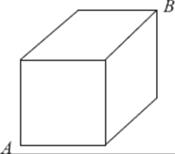
7. The figure above represents a cube whose edges are 3. What is the distance from vertex A to vertex B?
(A) 3
(B) ![]()
(C) ![]()
(D) 6
(E) 9
8. In a certain sequence the difference between any two consecutive terms is 5. If the 20th term is 63, what is the 2nd term?
(A) –32
(B) –27
(C) –22
(D) 32
(E) 37
9. What is the measure, in degrees, of the smaller angle formed by the hour hand and the minute hand of a clock at 11:20?
(A) 120
(B) 130
(C) 135
(D) 140
(E) 150
10. The following table lists the salaries in 2000 of five people and the percent changes in their salaries from 2000 to 2010.
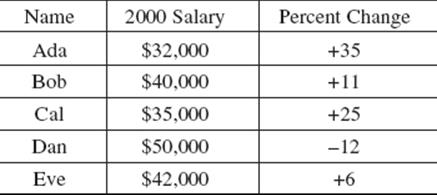
Who had the highest salary in 2010?
(A) Ada
(B) Bob
(C) Cal
(D) Dan
(E) Eve
11. 10% more than 10% less than x is what percent of 10x?
(A) 9%
(B) 9.9%
(C) 10%
(D) 99%
(E) 100%
12. If 2 – ![]() = 8, what is the value of x?
= 8, what is the value of x?
(A) 0
(B) 2
(C) 4
(D) 9
(E) There is no value of x that satisfies the equation
13. If x ≠ –1, 1, or 3, which of the following is equivalent to ![]()
(A) ![]()
(B) ![]()
(C) ![]()
(D) ![]()
(E) ![]()
14. If f(x) = x2 + ![]() and g(x) = f(4x), what is the value of g(4)?
and g(x) = f(4x), what is the value of g(4)?
(A) 18
(B) 36
(C) 72
(D) 144
(E) 260
15. So far this year, Adam has played 30 games of chess and has won only 6 of them. What is the minimum number of additional games he must play, given that he is sure to lose at least one-third of them, so that for the year he will have won more games than he lost?
(A) 25
(B) 34
(C) 57
(D) 87
(E) It is not possible for Adam to do this.
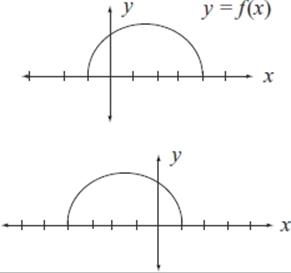
16. In the figure above, the graph on the top is the graph of y = f(x). Which of the following is the equation of the graph on the bottom?
(A) y = f(x + 3)
(B) y = f(x – 3)
(C) y = f(x) + 3
(D) y = f(x) – 3
(E) y = f(3x)
S T O P
YOU MAY GO BACK AND REVIEW THIS SECTION IN THE REMAINING TIME, BUT DO NOT WORK IN ANY OTHER SECTION UNTIL TOLD TO DO SO.
SECTION 10
Time—10 Minutes 14 Questions
For each of the following questions, select the best answer from the choices provided and fill in the appropriate circle on the answer sheet.
Some or all parts of the following sentences are underlined. The first answer choice, (A), simply repeats the underlined part of the sentence. The other four choices present four alternative ways to phrase the underlined part. Select the answer that produces the most effective sentence, one that is clear and exact, and blacken the appropriate space on your answer sheet. In selecting your choice, be sure that it is standard written English, and that it expresses the meaning of the original sentence.
Example:
The first biography of author Eudora Welty came out in 1998 and she was 89 years old at the time.
(A) and she was 89 years old at the time
(B) at the time when she was 89
(C) upon becoming an 89 year old
(D) when she was 89
(E) at the age of 89 years old
![]()
1. Helen is a trained veterinarian, and she has a specialization in the treatment of feline diseases.
(A) Helen is a trained veterinarian, and she has a specialization in the treatment of feline diseases.
(B) Helen is a trained veterinarian, moreover, she has a specialization in the treatment of feline diseases.
(C) Helen, a trained veterinarian, she has a specialization in treating feline diseases.
(D) As a trained veterinarian, Helen has got a specialization in how she should treat feline diseases.
(E) A trained veterinarian, Helen specializes in treating feline diseases.
2. The age of eighty-two having been reached, the children’s author Theodore Geisel (Dr. Seuss) startled the publishing world by writing You’re Only Old Once, a lighthearted book about the aches and pains of growing old.
(A) The age of eighty-two having been reached
(B) At eighty-two, when he had reached that age
(C) When having reached the age of eighty-two
(D) When he reached the age of eighty-two
(E) Having reached for the age of eighty-two
3. A turncoat is when someone is a traitor to a group or society to which he owes it to be loyal.
(A) is when someone is a traitor to a group or society to which he owes it to be loyal
(B) is when a person does treachery to a group or society to which he owes it to be loyal
(C) is someone who betrays a group or society to which he owes loyalty
(D) is a person which betrays a group or society to which he owes being loyal
(E) is where you betray a group or society to which you should be loyal
4. Like general contractors, writers are notorious optimistic when it comes to estimating how long a project will take.
(A) are notorious optimistic when it comes to estimating how long a project will take
(B) are notorious optimistic at estimating how long a project will take
(C) are notoriously optimistic when it comes to estimating how long a project will take
(D) are notoriously optimistic when they come to make an estimate of how long a project will take
(E) are notorious optimistic when it comes to estimating how long a project is liable to take
5. Bioengineered crops seem to have a way of turning up where they are not wanted, through cross-pollination, intermingling of seed, or other routes.
(A) through cross-pollination, intermingling of seed, or other routes
(B) through cross-pollination, intermingling of seed, and there are other routes
(C) by means of cross-pollination, and perhaps intermingling of seed, other routes
(D) through cross-pollination, they intermingle their seed, or taking other routes
(E) through cross-pollination, intermingling of seed, or there are other routes
6. There is a great deal of practical advice on antiques that readers may find useful in the mystery novels of Jonathan Gash.
(A) There is a great deal of practical advice on antiques that readers may find useful in the mystery novels of Jonathan Gash.
(B) There are great deals of practical advice regarding antiques that readers may find useful in Jonathan Gash’s mystery novels.
(C) Readers may find useful the great deal of practical advice on antiques in Jonathan Gash’s mystery novels.
(D) A great deal of practical and useful advice on antiques are offered to readers by Jonathan Gash in his mystery novels.
(E) In his mystery novels, Jonathan Gash offers readers a great deal of practical advice on antiques.
7. The movie’s unlikely happy ending came to pass as the result of an incredulous series of lucky accidents.
(A) came to pass as the result of an incredulous series
(B) came past as the result of an incredulous series
(C) came about through an incredulous series
(D) resulted from an incredulous series
(E) resulted from an incredible series
8. Although the folk singer specializes in singing British sea chanteys, he has never visited England and has no experience at sea.
(A) he has never visited England and has no experience at sea
(B) he has never visited England and also has never experienced being at sea
(C) it is without ever having visited England or ever having experienced being at sea
(D) he has never visited England nor has he had no experience at sea
(E) it is without ever visiting England and having experience at sea
9. The recent increase in the number of applicants to medical schools have encouraged hospital administrators, many of whom had bemoaned the lack of potential interns and physicians.
(A) have encouraged hospital administrators, many of whom had bemoaned
(B) have encouraged hospital administrators, whom many had bemoaned of
(C) has encouraged hospital administrators, many of them had bemoaned
(D) have encouraged hospital administrators, many of whom bemoaning
(E) has encouraged hospital administrators, many of whom had bemoaned
10. Having command of ballet, modern dance, as well as jazz, Jerome Robbins is regarded as an outstanding American choreographer.
(A) Having command of ballet, modern dance, as well as jazz
(B) Because of his command of ballet, modern dance, and jazz
(C) Because of him having a command of ballet, modern dance, and jazz
(D) With his command of ballet and modern dance and knowing jazz
(E) Being in command of ballet and modern dance and also his jazz side
11. Some people believe that one day we will create not only a universal health care system, but also the revitalized social security system will exist.
(A) we will create not only a universal health care system, but also the revitalized social security system will exist
(B) not only a universal health care system will be established but also the revitalized social security system will be in existence
(C) we will not only create a universal health care system, but we will revitalize the social security system in addition
(D) we will not only create a universal health care system, but also revitalize the social security system
(E) we will create not only a universal health care system, but a revitalized social security system also
12. Jane Smiley makes a convincing case that horses, like people, have their own natures, and that one can learn about them the same way you can learn about human beings: through observation, reading, and empathy.
(A) the same way you can learn about human beings
(B) in the same way you can learn about human beings
(C) the same way you could learn about human beings
(D) the same way one can learn about human beings
(E) only the same way one learns about human beings
13. Brought up in a homogeneous, all-white suburb, it was only when I moved to San Francisco that I realized how exciting life in an ethnically diverse community can be.
(A) it was only when I moved to San Francisco that I realized how exciting life in an ethnically diverse community can be
(B) I did not realize how exciting life in an ethnically diverse community can be until I moved to San Francisco
(C) when I moved to San Francisco I realized how exciting life in an ethnically diverse community can be
(D) an exciting life in an ethnically diverse community was unrealized by me until I moved to San Francisco
(E) moving to San Francisco made me realize how exciting life in an ethnically diverse community can be
14. For an overtly political cartoonist like Aaron McGruder, being free to criticize contemporary American society is more important than winning a large and admiring audience.
(A) being free to criticize contemporary American society is more important than
(B) there is greater importance in the freedom to criticize contemporary American society than in
(C) having freedom for criticism of contemporary American society is more important than
(D) to have the freedom to criticize contemporary American society is more important than
(E) freedom to criticize contemporary American society has more importance than does
S T O P
YOU MAY GO BACK AND REVIEW THIS SECTION IN THE REMAINING TIME, BUT DO NOT WORK IN ANY OTHER SECTION UNTIL TOLD TO DO SO.
Answer Key
Note: The letters in brackets following the Mathematical Reasoning answers refer to the sections of Chapter 9 in which you can find the information you need to answer the questions. For example, 1. C [E] means that the answer to question 1 is C, and that the solution requires information found in Section 9-E: Averages.
Section 2 Critical Reading
|
1. E 2. B 3. B 4. B 5. C 6. B 7. C 8. B |
9. B 10. D 11. E 12. A 13. B 14. A 15. E 16. B |
17. A 18. E 19. D 20. C 21. D 22. D 23. B 24. D |
Section 3 Mathematical Reasoning
|
1. C [A] 2. C [G] 3. D [A] 4. C [J] 5. B [A] 6. D [A] 7. A [H] |
8. E [C] 9. A [K, L] 10. A [D, H] 11. B [K, G] 12. D [M, C] 13. D [G] 14. A [R] |
15. A [J, K] 16. D [E, G] 17. E [H, L] 18. C [A] 19. C [P] 20. E [J] |
Section 4 Writing Skills
|
1. A 2. B 3. C 4. B 5. E 6. B 7. D 8. E 9. D 10. B 11. C 12. A |
13. E 14. D 15. C 16. C 17. A 18. A 19. D 20. B 21. D 22. A 23. C 24. C |
25. E 26. C 27. D 28. B 29. E 30. C 31. C 32. B 33. A 34. B 35. E |
Section 5
On this test, Section 5 was the experimental section. It could have been an extra critical reading, mathematics, or writing skills section. Remember: on the SAT you take, the experimental section may be any section from 2 to 7.
Section 6 Critical Reading
|
1. B 2. D 3. B 4. E 5. C 6. A 7. D 8. E |
9. C 10. C 11. D 12. C 13. B 14. A 15. C 16. D |
17. B 18. C 19. C 20. B 21. E 22. A 23. B 24. A |
Section 7 Mathematical Reasoning
Multiple-Choice Questions
|
1. C [A] 2. C [G] 3. B [G] |
4. B [L, N] 5. E [L, O] 6. A [A, D] |
7. E [R] 8. D [J, K] |
Grid-in Questions

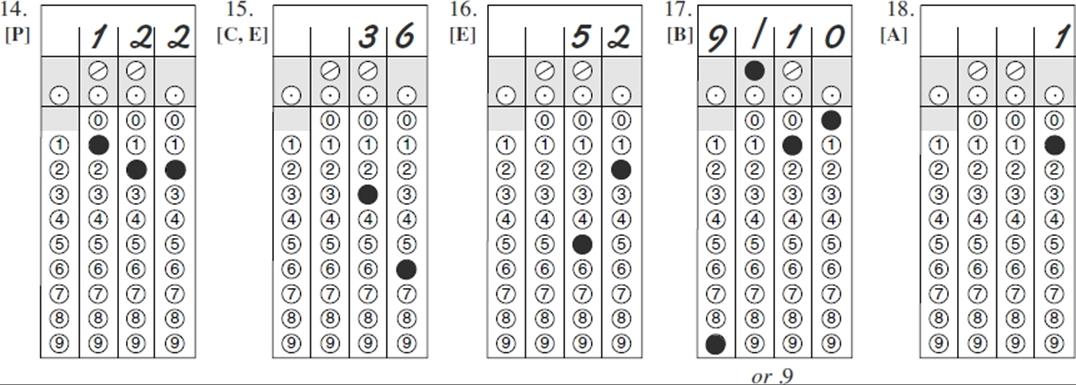
Section 8 Critical Reading
|
1. B 2. C 3. B 4. C 5. D 6. A 7. C |
8. E 9. D 10. C 11. C 12. A 13. C 14. E |
15. A 16. D 17. A 18. A 19. A |
Section 9 Mathematical Reasoning
|
1. B [D] 2. E [B, C] 3. B [A] 4. B [A] 5. C [K] 6. D [J] |
7. C [M] 8. B [P] 9. D [I, P] 10. E [C, Q] 11. B [C] 12. E [G] |
13. A [F] 14. E [R] 15. C [G, H] 16. A [R] |
Section 10 Writing Skills
|
1. E 2. D 3. C 4. C 5. A |
6. B 7. E 8. A 9. E 10. B |
11. D 12. D 13. B 14. A |
Score Your Own SAT Essay
Use this table as you rate your performance on the essay-writing section of this Model Test. Circle the phrase that most accurately describes your work. Enter the numbers in the scoring chart below. Add the numbers together and divide by 6 to determine your total score. The higher your total score, the better you are likely to do on the essay section of the SAT.
Note that on the actual SAT two readers will rate your essay; your essay score will be the sum of their two ratings and could range from 12 (highest) to 2 (lowest). Also, they will grade your essay holistically, rating it on the basis of their overall impression of its effectiveness. They will not analyze it piece by piece, giving separate grades for grammar, vocabulary level, and so on. Therefore, you cannot expect the score you give yourself on this Model Test to predict your eventual score on the SAT with any great degree of accuracy. Use this scoring guide instead to help you assess your writing strengths and weaknesses, so that you can decide which areas to focus on as you prepare for the SAT.
Like most people, you may find it difficult to rate your own writing objectively. Ask a teacher or fellow student to score your essay as well. With his or her help you should gain added insights into writing your 25-minute essay.

|
Self-Scoring Chart |
Scoring Chart (Second Reader) |
||
|
For each of the following categories, rate the essay from 1 (lowest) to 6 (highest) |
For each of the following categories, rate the essay from 1 (lowest) to 6 (highest) |
||
|
Position on the Topic |
|
Position on the Topic |
|
|
Organization of Evidence |
|
Organization of Evidence |
|
|
Sentence Structure |
|
Sentence Structure |
|
|
Level of Vocabulary |
|
Level of vocabulary |
|
|
Grammar and Usage |
|
Grammar and Usage |
|
|
Overall Effect |
|
Over Effect |
|
|
TOTAL |
|
TOTAL |
|
|
(To get a score, divide the total by 6) |
|
(To get a score, divide the total by 6) |
|
Calculate Your Raw Score
Critical Reading
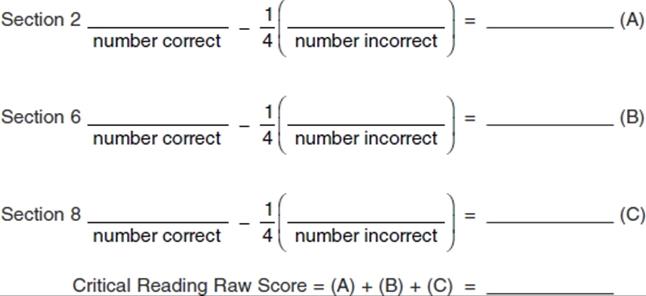
Mathematical Reasoning
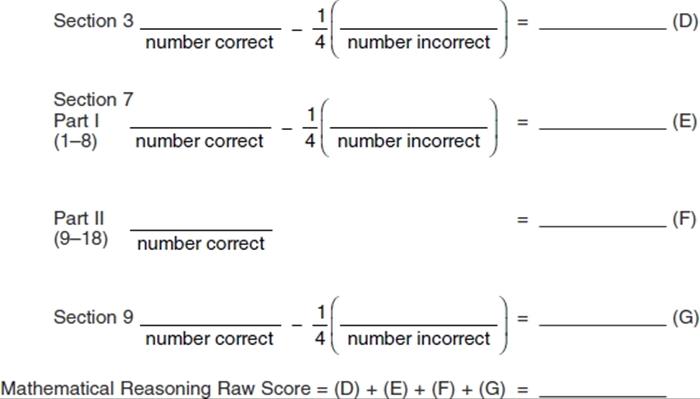
Writing Skills
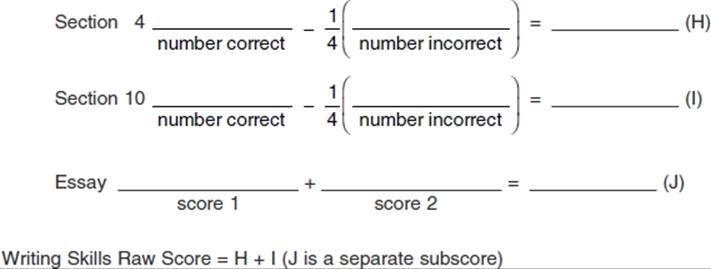
Evaluate Your Performance
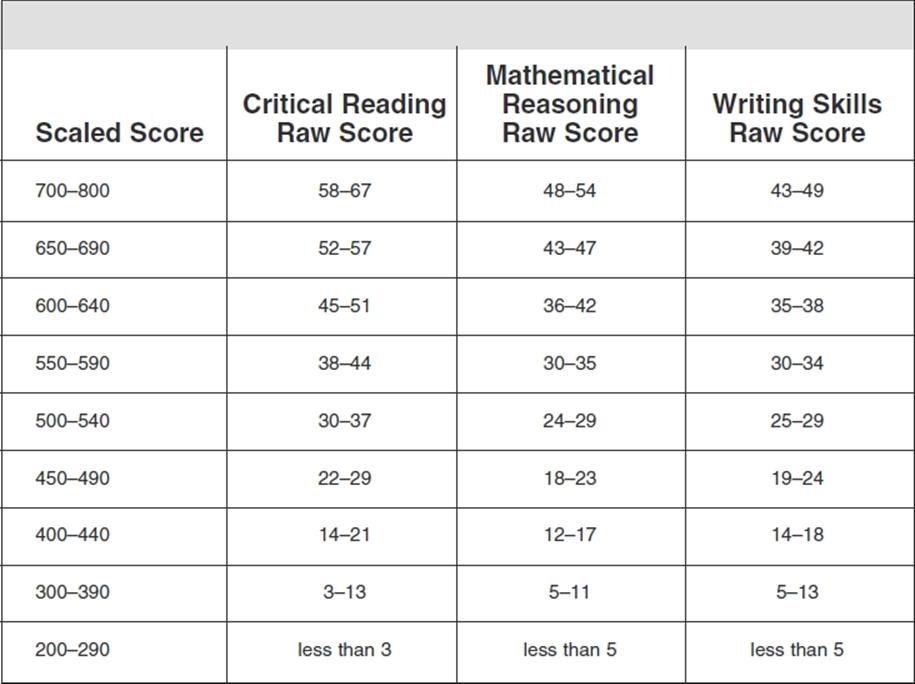
Identify Your Weaknesses
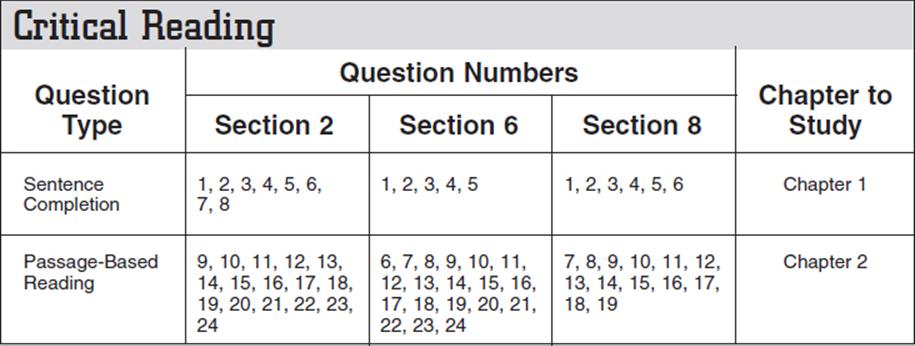
Identify Your Weaknesses
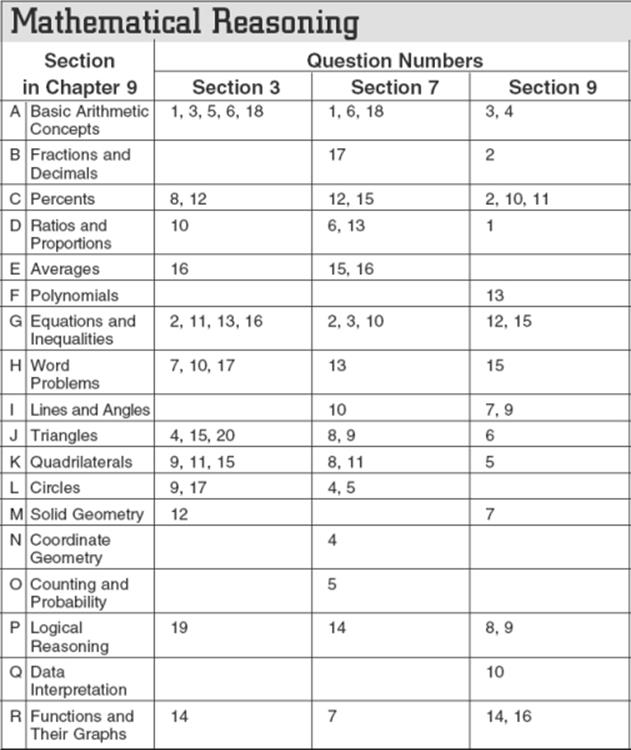
Identify Your Weaknesses
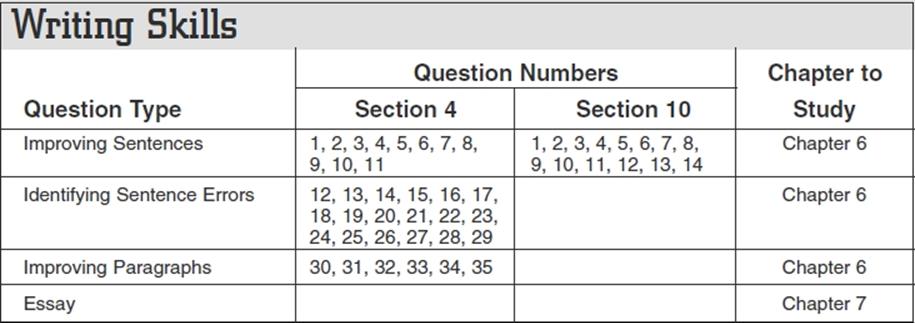
ANSWERS EXPLAINED
Section 2 Critical Reading
1. E. The subject considers himself talented and creative and thinks office work is uninspiring, dull—in a word, prosaic.
Note that the missing word must be a synonym or near-synonym for “uninspiring.”
Connected by the linking verb was, both words describe or define the office routine.
(Definition)
2. B. A chronological order is one arranged in order of time. The missing word is an adjective describing the order in which the museum arranged the fossils. The second part of the sentence defines that order: from older to more recent in time.
Word Parts Clue: Chron- means time.
(Definition)
3. B. Thanks to the development of wings, insects were able to disperse or scatter over Earth’s surface. Thus, they were able to reach new habitats and untapped sources of nourishment.
(Cause and Effect Pattern)
4. B. For London to miss out on (fail to attract) two major international art exhibitions marks it as a failure or also-ran in the blockbuster-hungry world of international art museums.
(Cause and Effect Pattern)
5. C. The critics are riled or irritated by the condescending, superior tone of the magazine’s editorials.
Note how the section of the sentence following the blank illustrates what aspect of the magazine annoys its critics.
(Example)
6. B. Although the Supreme Court nominee had a compassionate nature, nevertheless she was strict and unbending (uncompromising) in sticking or adhering to the law.
Note that “although” signals a contrast. Look at the first word of each answer choice to see if it is an antonym for “compassionate by nature.” You can immediately eliminate Choices A, C, and E.
Choice D is incorrect. Someone truly compassionate by nature would not be vindictive or vengeful.
(Contrast Signal)
7. C. To observe the adage “Look before you leap” is to be cautious. In this instance, however, the subject did not look before he leaped. Instead, he was precipitate (hasty, rash) in acting in a thoughtless, unconsidered manner.
Again, “although” signals a contrast. Look at each answer choice to see if it is an antonym for being cautious.
(Contrast Signal)
8. B. Because these seals eat far more krill than crabs, to call them crabeater seals is to misname them.
The term is thus a misnomer, a name that’s wrongly applied to someone or something.
Beware of Eye-Catchers. Choice A is incorrect. A pseudonym isn’t a mistaken name; it’s a false name that someone, especially an author, adopts.
Remember: this is the last sentence completion question of a set of eight. If you have to guess, try the least familiar word among the answers.
(Cause and Effect Signal)
9. B. By embracing Ibsen’s controversial dramas, the British intellectuals adopted them, making them their own.
10. D. The author states that Marx “went so far as” to teach herself Norwegian in order to translate Ibsen. This action on Marx’s part demonstrates her ardent championing of the Norwegian dramatist. It supports the earlier assertion that British intellectuals “wholeheartedly embraced” Ibsen’s works.
11. E. The author is contradicting the social critics’ conclusion that income growth no longer promotes well-being. He points to his personal experience to show that his increased income has led to a greater sense of well-being on his part.
12. A. The author’s use of the colloquial exclamation “Great!,” his casual suggestion of purchasing a hybrid vehicle, and his slangy, informal wording (“having money sure takes the pressure off”) all contribute to the breezy, carefree tone.
13. B. The author contrasts Popeye with Mickey, referring to Popeye as “aggressive” and “self-promoting.” These relatively negative terms indicate that the author’s attitude toward Popeye is deprecatory or disparaging.
14. A. Unlike Popeye, Mickey does not promote or boast about himself: he lets his skills remain unsuspected. Similarly, when danger strikes, Mickey does not push himself forward: he is a reluctant hero. These traits reveal Mickey’s modest, unassuming nature.
15. E. The scrapes Mickey gets into are predicaments (difficult situations).
16. B. Immediately before quoting Disney’s assertion that there was a lot of the Mouse in him, the author states that the image of Mickey as a pretty nice, harmless, good-natured sort of guy “was perhaps Disney’s image of himself.”
Disney pictured himself as Mickey, scrambling and struggling and yet always managing to come up grinning. Thus, by saying “There’s a lot of the Mouse in me,” Disney revealed the extent of his identification with his creation.
17. A. The author has been developing Disney’s positive image of Mickey as a pretty nice fellow, showing how Disney’s background led to his identifying himself with the humble, scrambling mouse. He then suddenly goes off on a side topic, explaining why the Nazis during World War II had a negative image of Mickey. Clearly, he is digressing, straying from the subject at hand.
18. E. Disney is described as being nice “until crossed.” If someone opposed him and stood in the way of his reaching his artistic and business goals, he quit being nice.
19. D. Disney was not the inventor of film animation.
As the passage indicates, the technology “would have been there anyway.”
20. C. Both President Roosevelt, who insisted on being shown Mickey Mouse cartoons, and the African tribesmen, who had Mickey’s image set into their teeth, are examples of people around the globe who enjoyed Mickey Mouse.
The author uses these examples to support the assertion that Mickey’s image was known around the world—it was popular all over Africa as well as in the United States—and that powerful people as well as primitive tribesmen, people of all backgrounds, were drawn to Mickey Mouse.
21. D. According to the passage, “something timeless in the image” transforms the status of a fad or passing fancy to that of an icon (a sign that stands for the object it represents because of some resemblance between the two; often a sacred image venerated by people). The fad is clearly less enduring in appeal than is the icon.
22. D. The author wishes to show how strong a hold Mickey has on America’s collective awareness. To do so, he revitalizes a familiar cliché.
Mickey does not simply grab our imaginations; he takes a bite out of them. In other words, he forcefully captures our fancies.
23. B. The key shaped out of three connected circles does not present a realistic, detailed likeness of Mickey Mouse. It fails to show his nose, his eyes, his mouth—the usual identifying features. Nevertheless, this simple, bare outline is unmistakably Mickey: anyone who looks at it knows it is an image of Mickey Mouse. This clearly shows that even a rudimentary outline can convey the image of Mickey.
24. D. The new Disney gadget is described as representing Mickey’s image in the simplest, most rudimentary fashion: “three circles, two mounted on a larger one, [whose] image is unmistakably Mickey.” Only the waffle iron, turning out its three-ringed, featureless (but unmistakable) Mickey Mouse waffles, presents Mickey as an artifact, a manufactured object, rather than as the commercially generated, representational image of the familiar cartoon figure in red shorts.
Section 3 Mathematical Reasoning
In each mathematics section, for many problems, an alternative solution, indicated by two asterisks (**), follows the first solution. When this occurs, one of the solutions is the direct mathematical one and the other is based on one of the tactics discussed in Chapter 8 or 9.
1. C. Just look at each number carefully. The hundreds place is the third from the left of the decimal point, and the hundredths place is the second to the right of the decimal point: 2242.4242.
2. C. If Beth has twice as many cards as Bruce, Bruce has half as many as Beth: ![]()
**This is so easy that you shouldn’t have to plug in a number, but you could: If Beth has 10 cards, Bruce has 5, and only ![]() equals 5 when b is 10.
equals 5 when b is 10.
3. D. To convert 225 minutes to hours, divide by 60: the quotient is 3 and the remainder is 45. Therefore, 225 minutes from 9:05 is 3 hours and 45 minutes from 9:05 A.M., that is, 12:50 P.M.
![]() **If you divide 225 by 60 on your calculator, you get 3.75; then you have to convert 0.75, or
**If you divide 225 by 60 on your calculator, you get 3.75; then you have to convert 0.75, or ![]() , of an hour to 45 minutes.
, of an hour to 45 minutes.
4. C. By KEY FACT J2, the measure of an exterior angle of a triangle is equal to the sum of the measures of the two opposite interior angles, so 140 = x + x = 2x ![]() x = 70.
x = 70.
**If you don’t remember this fact, label the third angle in the triangle y. Then 140 + y = 180, and so y = 40. Now solve the equation 40 + x + x = 180:
40 + 2x = 180 ![]() 2x = 140
2x = 140 ![]() x = 70.
x = 70.
5. B. Let x and y be the two numbers: x – y > x + y ![]() –y > y
–y > y ![]() 0 > 2y
0 > 2y ![]() y is negative.
y is negative.
Therefore, at least one of the numbers is negative. [Note that there are no restrictions on x: x – (–1) = x + 1, which is greater than x + (–1) = x – 1, no matter what x is.]
6. D. By the laws of exponents (KEY FACT A16), (3a2b3)3 = 33(a2)3(b3)3= 27a6b9.
![]() **Use TACTIC 6: substitute numbers. If a and b are 1, (3a2b3)3 = 33 = 27. Eliminate A and B. If a = 1 and b = 2, (3a2b3) = (3·1·8)3 = 243. Use your calculator to evaluate 243 = 13,824; then test choices C (which doesn’t work) and D: 27a6b9.
**Use TACTIC 6: substitute numbers. If a and b are 1, (3a2b3)3 = 33 = 27. Eliminate A and B. If a = 1 and b = 2, (3a2b3) = (3·1·8)3 = 243. Use your calculator to evaluate 243 = 13,824; then test choices C (which doesn’t work) and D: 27a6b9.
7. A. If y years ago Anne-Marie was x years old, she is now x + y, and in z years she will be x + y + z.
**Use TACTIC 6: substitute numbers. If 2 years ago Anne-Marie was 10, how old will she be in 3 years? She is now 12 and in 3 years will be 15. Only x + y + z (A) equals 15 when x = 10, y = 2, and z = 3.
8. E. Solve the equation, 10 = ![]() 1000 = xA
1000 = xA ![]() x =
x = ![]() %.
%.
**Use TACTIC 6: substitute an easy-to-use number. 10 is 100% of 10. Which choices are equal to 100% when A = 10? Both A and E. Eliminate B, C, and D, and try another number: 10 is 50% of 20. Of A and E, only ![]() equals 50 when A = 20.
equals 50 when A = 20.
9. A. Refer to the figures below.
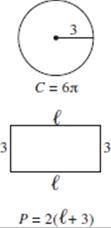
Since the formula for the circumference of a circle is 2![]() r, the circumference of this circle is 6
r, the circumference of this circle is 6 ![]() (KEY FACT L4). By KEY FACT K7, the perimeter of a rectangle is 2(
(KEY FACT L4). By KEY FACT K7, the perimeter of a rectangle is 2( ![]() + w), so here P = 2(
+ w), so here P = 2( ![]() + 3).
+ 3).
6![]() = 2(
= 2(![]() + 3)
+ 3)![]()
![]() + 3 = 3π
+ 3 = 3π ![]()
![]() = 3
= 3![]() – 3.
– 3.
10. A. Let x be the number of marbles that Anthony has. Then 3x is ![]() the number of marbles Billy has, so Billy has 9x marbles. The ratio is x:9x or 1:9.
the number of marbles Billy has, so Billy has 9x marbles. The ratio is x:9x or 1:9.
**Use TACTIC 7: pick an easy-to-use number. Assume that Anthony has 1 marble. If he had 3 times as many, he would have 3; and if 3 is ![]() the number that Billy has, Billy has 9. The ratio is 1:9.
the number that Billy has, Billy has 9. The ratio is 1:9.
11. B. It is given that ![]() also
also ![]() since they are opposite sides of a rectangle. Label each of them w, as shown in the figure.
since they are opposite sides of a rectangle. Label each of them w, as shown in the figure.
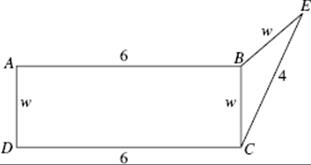
Then R = 12 + 2w and T = 4 + 2w, so R – T = 8.
12. D. The volume of the small tank is ![]() r2h, and the volume of the large tank is
r2h, and the volume of the large tank is ![]() (2r)2h, which equals 4
(2r)2h, which equals 4![]() r2h, so the large tank is 4 times the size of the small one. Be careful! This is an increase of 300%, not 400%. (4 is 3 more than 1, so is 300% more than 1.) Therefore, k = 300.
r2h, so the large tank is 4 times the size of the small one. Be careful! This is an increase of 300%, not 400%. (4 is 3 more than 1, so is 300% more than 1.) Therefore, k = 300.
13. D. Since  is a number box, xy = 4 × 6 = 24 and x = 4 + y + 6, so
is a number box, xy = 4 × 6 = 24 and x = 4 + y + 6, so
x = 10 + y ![]() y = 2 and x = 12.
y = 2 and x = 12.
Therefore, x + y = 12 + 2 = 14.
14. A. f(a) = a ![]() 3a + 8 = a
3a + 8 = a ![]() 8 = –2a
8 = –2a ![]() a = –4.
a = –4.
15. A. If the hypotenuse of a 30-60-90 right triangle is 2, the legs are 1 and ![]() Therefore, each side of square RSTU is 1 +
Therefore, each side of square RSTU is 1 + ![]() , and the perimeter is 4 times that value: 4 + 4
, and the perimeter is 4 times that value: 4 + 4![]()
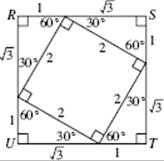
16. D. Use TACTIC 17. When you have three equations, add them:

Divide by 2: x + y + z = ![]()
Divide by 3: ![]() =
= ![]()
**Use TACTIC 6: substitute for the variables.
Let x = 1, y = 2, and z = 3. Then the average of x, y, and z is 2. When a = 1 + 2 = 3, b = 2 + 3 = 5, and c = 1 + 3 = 4, which of the choices equals 2? Only ![]()
17. E. Since C = 2 ![]() r (KEY FACT L4), 2
r (KEY FACT L4), 2 ![]() r =
r = ![]()
![]() r =
r = ![]() =
= ![]() . Then, by KEY FACT L8, the area of the field is
. Then, by KEY FACT L8, the area of the field is ![]() =
= ![]() =
= ![]() = 3600 square meters.
= 3600 square meters.
Finally, since Eric can mow 400 square meters of grass per hour, he will take 3600 ÷ 400 = 9 hours to mow the entire field.
18. C. Replacing a by 2a, b by 3b, and c by 4c gives ![]() =
= ![]() =
= ![]() =
= ![]() X = 4.5X
X = 4.5X
In words, X is multiplied by 4.5.
**Use TACTIC 6. Let a = 1, b = 2, and c = 3. Then X = ![]() =
= ![]() . Now let a = 2, b = 6, and c = 12; what will X be?
. Now let a = 2, b = 6, and c = 12; what will X be?
![]()
![]() =
= ![]() = 6. By what must
= 6. By what must ![]() be multiplied to get 6? The calculation is as follows: 6 ÷
be multiplied to get 6? The calculation is as follows: 6 ÷ ![]() = 6 ×
= 6 × ![]() =
= ![]() = 4.5.
= 4.5.
19. C. ![]() Since the pattern has six digits, divide 135 by 6. The quotient is 22, and the remainder is 3.
Since the pattern has six digits, divide 135 by 6. The quotient is 22, and the remainder is 3.
Since 22 × 6 = 132, the 132nd number completes the pattern for the 22nd time. Then the 133rd, 134th, and 135th numbers are 1’s, and the 136th and 137th are 2’s; and their sum is 1 + 2 + 2 = 5.
20. E. If you think to reduce the ratio 5:5:10 to 1:1:2, fine; if not, just write
180 = 5x + 5x + 10x = 20x ![]() x = 9,
x = 9,
and so the angles measure 45°, 45°, and 90°.
By KEY FACT J8, if you know the length of any side of a 45-45-90 right triangle, you can find the other sides and hence the area (I), the perimeter (II), and the lengths of the altitudes (III), two of which are the legs. Statements I, II, and III are true. (Note: You should not waste any time actually finding the area, the perimeter, or the altitudes.)
Section 4 Writing Skills
1. A. Sentence is correct.
2. B. The original sentence contains a dangling modifier, as does Choice D. Choices C and E are wordy and awkward. Only Choice B corrects the error and is an effective, concise sentence.
3. C. Error in subject-verb agreement. The authors (plural) have largely conquered their subject (singular). Only Choice C corrects the error in subject-verb agreement without introducing a fresh error.
4. B. Error in parallelism. Choice B repairs the lack of parallel structure without introducing fresh errors.
5. E. Error in placement. The concluding phrase in the original is both misplaced and awkwardly worded.
6. B. Lack of parallelism. Choice B supplies the desired parallel structure.
7. D. Error in usage. When three or more persons are named, use last instead of latter. (Although Choice E does substitute last for latter, it introduces an error in subject-verb agreement.)
8. E. Error in parallelism. To make the parallel clear, repeat the preposition. Lewis spoke as eloquently on Christianity as on literature.
9. D. Error in parallelism. To correct the error, change intimidating to intimidate. Remember: all items in a series should have the same form.
10. B. Dangling modifier. What was only partially defrosted, the meal or the attendant? Clearly, it was the meal. Choice B clears up the confusion economically.
11. C. Do not use when after is unless you are making a statement about time (“3:00 P.M. is when I take my next pill”). Replace “A factor...is when” with “A factor...is that.”
12. A. Error in word usage. Irregardless is nonstandard. Substitute Regardless.
13. E. Sentence is correct.
14. D. Error in parallelism. Change and how they organized the militia to and the organization of the militia.
15. C. Error in subject-verb agreement. Not one of the more than two thousand rooms was equipped with sprinklers.
16. C. Error in word usage. Raise, a transitive verb, means to lift something upward; rise, an intransitive verb, means simply to move upward. Backstage, stagehands pull on ropes to raise the curtain. From the viewpoint of the audience out front, the curtain simply rises.
17. A. Error in subject-verb agreement. The subject, progress, is singular; the verb should be singular as well. Change have been to has been.
18. A. Shift of personal pronoun. Do not switch person from one to you.
19. D. Error in logical comparison. Change any to any other.
20. B. Error in comparison. Unique is an absolute adjective, one without degrees of comparison.
Do not describe something as most unique; either it is unique (one of a kind) or it is not unique.
21. D. Error in idiom. The animal pathogen is capable of infecting human cells.
22. A. Error in subject-verb agreement. Remember that in some sentences the subject follows the verb. Here the subject is plural: discussion and performance. The sentence should begin “Also in the program are a taped discussion...and a performance.”
23. C. Error in comparison. Change more to most.
24. C. Error in comparison. Change less to lesser (the comparative form of the adjective).
25. E. Sentence is correct.
26. C. Incorrect conjunction. Change while to and.
27. D. Incomplete comparison. Compare performances with performances, not performances with dancers. Change “than the other dancers” to “than those of the other dancers.”
28. B. Error in diction. Substitute likely for liable.
29. E. Sentence is correct.
30. C. Choice A implies that the essay’s purpose is to admire the technological achievements of the twentieth century. The essay, however, has another purpose. Choice B is similar to A and also contains an inappropriate colloquialism.
Choice C accurately captures the essay’s theme—that technological progress is neither all good nor all bad. It is the best answer.
Choice D suggests that the essay will discuss the prospects for continued technological progress, but the essay has a different purpose.
Choice E names the three areas discussed in the essay but, contrary to the point of the essay, suggests that we would be better off without technological progress.
31. C. Choice A unnecessarily repeats energy and contains an incomplete comparison. Energy is cheaper than what? Choice B contains an incomplete comparison. Energy is cheaper than what? It also contains an error in parallel construction. Choice C is succinct and accurately expressed. It is the best answer. Choice D contains an error in parallel construction. Choice E also contains a faulty comparison. Cheaper and easier than what?
32. B. Although related to communications, the information contained in sentence 6 is not germane to the discussion of communication satellites. Therefore, B is the best answer.
33. A. Choice A is consistent in style and tone to the sentences preceding and following sentence 15. It is the best answer. Choice B is a sentence fragment. Choice C contains the nonstandard usage, hardly no, which is a double negative. Choice D contains a sudden shift to second person, which does not fit the tone and style of the preceding and following sentences. Choice E is needlessly repetitious.
34. B. Choice A does not accurately describe either the paragraph structure or the point of the essay. Choice B precisely describes the structure of each paragraph. It is the best answer.
Choices C and D describe neither the paragraph structure nor the point of the essay.
Choice E is an inference that might be drawn from the essay, but the writer never directly advocates greater funding.
35. E. Choice A unnecessarily repeats CAT scan and contains faulty parallelism. Choice B unnecessarily repeats CAT scan and is needlessly wordy. Choice C contains a dangling participle. The phrase that begins Taking picturesshould modify doctors, not brain. Choice D does not make a clear, explicit connection with the preceding sentence. Choice E is a succinct and error-free follow-up to the preceding sentence. It is the best answer.
Section 6 Critical Reading
1. B. The words “merely” and “failed to highlight” indicate that the woman is dissatisfied with the job-seeker’s resume. It lacks some qualities she thinks it needs. It is inadequate, not up to standards, deficient.
Note that you are looking for a word with negative associations. Therefore, you can eliminate any word with positive ones. Choices C and E both have positive associations. Only Choice A, B, or D can be correct.
(Examples)
2. D. Most medical research is aimed at helping human beings. Therefore, having discovered something about the cause of a disease affecting animals, it would be perfectly reasonable or logical for researchers to wish to apply their findings to the treatment of humans.
Remember: before you look at the choices, read the sentence and think of a word that makes sense.
Watch for signal words that link one part of the sentence to another. The use of “Because” in the opening clause is a cause signal. Ask yourself what would be a logical next step after finding out that a kind of virus caused cancer in animals.
(Cause and Effect Signal)
3. B. The key phrase here is “treated her badly.”
Because the news media have misrepresented her, distorting or misstating her comments, Ms. Ono does not like to give interviews.
Therefore, she gives them rarely.
Remember to watch for signal words that link one part of the sentence to another. The use of “because” introducing the second clause sets up a pattern of cause and effect. Note also the use of the support signal and, here letting you know that the second missing word must be a synonym or near-synonym for “treated her badly.”
(Cause and Effect Signal/Support Signal)
4. E. The introduction of metal tools significantly improved totem craftsmanship: because the carvers had better tools, they could do better, “more sophisticated” or advanced work. Thus, thanks to the introduction of metal tools, totem craftsmanship reached its high point or apex.
(Cause and Effect Pattern)
5. C. Admirers of realism would not esteem “the stuff of legend”; they prefer fallible, ordinary people to mythic figures who seem larger-than-life. They thus prefer a film that shuns or rejects make-believe in order to tell a plain, unembellished tale.
Note the cause-and-effect signal because. The sentence explains why Malle’s realistic film succeeds.
(Cause and Effect Signal)
6. A. The capacity in question is the bear’s remarkable ability to smell its prey from a phenomenal distance away.
7. D. Passage 1 describes the polar bear’s layers of blubber and fur, its broad paws, its sharp claws—in other words, its physical characteristics.
8. E. The author of Passage 2 establishes a time frame. First, she cites a threat to polar bear survival that occurred “In the mid-twentieth century.” Then, she refers to a 1973 agreement that diminished that threat. Finally, she mentions a new threat that exists “Today.”
9. C. Passage 1 describes polar bears as formidable hunters; Passage 2 terms them top predators and fearsome killers. Both passages support the generalization that polar bears are notable predators.
10. C. Choice C is correct. You can arrive at it by the process of elimination.
Statement I is true. Sir Walter’s vanity was “vanity of person.” He was vain about his personal appearance, his physical attractiveness. Therefore, you can eliminate Choice B.
Statement II is true. Sir Walter’s vanity was also vanity “of situation.” He was vain about his position in society, his titled rank. There-fore, you can eliminate Choices A and D.
Statement III is untrue. Sir Walter’s wife, not Sir Walter, was superior in character.
Therefore, you can eliminate Choice E.
Only Choice C is left. It is the correct answer.
11. D. The narrator does not commend Lady Elliot for falling in love with Sir Walter, calling it a “youthful infatuation,” the only misjudgment in an otherwise blameless life. Therefore, Choice D is correct.
The narrator speaks well of Lady Elliot for concealing Sir Walter’s shortcomings: she has “promoted his real respectability.” Choice A is supported by the passage. Therefore, it is incorrect.
The narrator commends Lady Elliot for her choice of a friend: she has chosen “a sensible, deserving woman,” one who even moves into the neighborhood to be near her. Choice B is supported by the passage. Therefore, it is incorrect.
The narrator speaks well of the way Lady Elliot guides her daughters: she has given them “good principles and instruction.”
Choice C is supported by the passage.
Therefore, it is incorrect.
Choice E is incorrect. The narrator clearly commends Lady Elliot in her performance of her duties as a wife.
12. C. The narrator’s statement that Lady Elliot was “not the very happiest being in the world herself” is preceded by a list of all Lady Elliot had to do to cover up for her “conceited, silly” husband. Thus we can infer that the cause of her unhappiness was the difference or disparity between her character and that of her husband.
Choice A is incorrect. Nothing in the passage suggests Lady Elliot lacks beauty. Indeed, we suspect that Sir Walter, so conscious of his own beauty, would not have chosen an unattractive wife.
Choice B is incorrect. Lady Elliot’s best friend had moved to be near her; they were not separated.
Choice D is incorrect. Lady Elliot’s social position was, at least in Sir Walter’s eyes, superior, not inferior.
Choice E is incorrect. Nothing in the passage suggests that Lady Elliot’s daughters were wayward.
13. B. Choice B is correct. The narrator tells little directly of Lady Elliot’s feelings about dying.
However, such phrases as “Three girls...was an awful legacy to bequeath” and “anxiously giving her daughters [instruction]” show us something of her mind. Her concern centers not on herself but on those she must leave behind: her daughters. Her emotions as she faces death are complicated by anxieties over her daughters’ prospects.
Choice A is incorrect. Nothing in the passage suggests resignation or pious submissiveness on her part.
Choices C and D are incorrect. Both are unsupported by the passage.
Choice E is also incorrect. Lady Elliot clearly has faced the reality of her approaching death: she realizes that she is leaving her daughters to the care of her conceited, silly husband.
14. A. Lady Elliot in “quitting” her family is not simply taking a trip: she is dying. We expect a person facing death to react strongly, emotionally. Instead, the narrator states that Lady Elliot was merely attached enough to life to make dying “no matter of indifference to her.”
That is clearly an understatement. It is an example of irony, the literary technique that points up the contradictions in life, in this case the contradiction between the understated expression and the deeply felt reality.
15. C. Sir Walter’s applications have been marital ones. In his conceit, he has applied for the hand in marriage of some women who were far too good for him (his applications were unreasonable). Sensibly enough, these women have turned him down (he has been disappointed in his proposals of matrimony). However, his conceit is undiminished: he prides himself on remaining single for his dear daughters’ sake.
16. D. The opening sentence describes the shattering of the Iroquois leadership’s pro-British policy.
The remainder of the passage describes how Iroquois policy changed to reflect changes in European military goals.
Choice A is incorrect. The passage is expository, not accusatory.
Choice B is incorrect. Nothing in the passage suggests that such charges were made against the Iroquois.
Choice C is incorrect. It is unsupported by the passage.
Choice E is incorrect. The passage demonstrates the Iroquois were able to play European power politics.
Remember: when asked to find the main idea, be sure to check the opening and summary sentences of each paragraph.
17. B. The Europeans designated or called these confederations of Indian tribes nations, giving them the same title they used for European states.
18. C. In this sentence, “rough” means approximate, as in “a rough guess.” The tribes dealt with Europeans as approximate equals, not as exact or absolute equals.
19. C. The author presents the Iroquois Confederacy’s experience “as an example of the process that all the interior nations experienced.” Thus, he regards what happened to the Iroquois as representative or typical of the experiences of the other interior tribes.
20. B. In lines 61–63, the author states that the Iroquois “played the game of European power politics with effectiveness.” Thus, he shows respect for their competence.
None of the other choices is supported by the passage.
Remember: when asked to determine the author’s attitude or tone, look for words that convey value judgments.
21. E. Lines 45–63 indicate that in the early 1700s and through most of the eighteenth century the Iroquois did hold the balance of power.
Therefore, Choice E is the correct answer.
Choice A is incorrect. The raid on Lachine was an effective response to French aggression, as was the Iroquois-enforced policy of aggressive neutrality.
Choice B is incorrect. James II’s overthrow was followed by colonial uprisings.
Choice C is incorrect. In response to the Iroquois leaders’ supposed favoring of the British (lines 63–69), the French went to war.
Choice D is incorrect. This sums up the policy of aggressive neutrality.
22. A. Lines 57–60 indicate that the Iroquois played the game of power politics with effectiveness “by their willingness to use their power against one or the other nation.” In other words, they were ready to fight either side.
Choice B is incorrect. Ties of loyalty may actually have hampered the Iroquois; the French fear that the Iroquois were compromising the system in favor of the British led to the eventual breakdown of the policy of neutrality.
Choice C is incorrect. French presence in the borderlands would have been a challenge to Iroquois power.
Choices D and E are incorrect. They are unsupported by the passage.
23. B. The French believed that the Iroquois were jeopardizing or undermining the system of Iroquois neutrality by making decisions that favored the English.
24. A. The opening paragraph describes the changing state of relationships between the European powers and the tribes of the interior during the eighteenth century. As more and more French and English settlers moved into the interior, the Indian nations had to find new ways of dealing with the encroaching French and English populations. The paragraph concludes by stating: “The history of the reorientation of Iroquois policy toward the Europeans may serve as an example of the process that all the interior nations experienced in the eighteenth century.” Thus, the next three paragraphs, which sum up the Iroquois’ experience, provide an instance of a state of relationships described earlier.
Section 7 Mathematical Reasoning
MULTIPLE-CHOICE QUESTIONS
1. C. A = {1, 3, 5, 7, 9} and B = {2, 3, 5, 7}. The positive integers less than 10 that are in neither A nor B are 4, 6, and 8. There are 3 of them.
2. C. Let x be Mr. Gomes’s number.
Then x + 3 = 3x ![]() 3 = 2x
3 = 2x ![]() x = 1.5.
x = 1.5.
**Use TACTIC 5: backsolve. Start with C:
1.5 + 3 = 4.5 and 1.5 × 3 = 4.5. It works.
3. B. The easiest solution is to quickly reduce, either by dividing by 16 (if you recognize that 64 = 4 × 16) or by repeatedly dividing each side by 8: ![]()
![]() Then n =
Then n = ![]()
![]() n = 1.
n = 1.
**Of course, you can rewrite the equation as
![]()
and use your calculator: n2 = 1.
4. B. ![]() By the distance formula (KEY FACT N2), the length of diameter AB is
By the distance formula (KEY FACT N2), the length of diameter AB is![]()
Then the radius of the circle is ![]() , and the area of the circle is
, and the area of the circle is ![]()
![]() =
= ![]()
![]() = 17
= 17 ![]() .
.
5. E. Since no numbers were given, choose a simple value for the length of diameter BC of the small semicircle, say 2. Then the small semicircle has a radius of 1, and its area is ![]()
![]() (1)2 =
(1)2 = ![]() . Since AB = BC = CD = 2, then AD, the diameter of the large semicircle, has length 6, and so the radius is 3. Then the area of the large semicircle is
. Since AB = BC = CD = 2, then AD, the diameter of the large semicircle, has length 6, and so the radius is 3. Then the area of the large semicircle is ![]() Finally, the area of the shaded region is
Finally, the area of the shaded region is ![]() and the probability that the point lies in the shaded region is
and the probability that the point lies in the shaded region is 
**Since the ratio of the radii is ![]() , the ratio of the areas is
, the ratio of the areas is ![]() . Then the white semicircle is
. Then the white semicircle is ![]() and the shaded region is
and the shaded region is ![]() of the entire figure.
of the entire figure.
6. A. Cross-multiply: r(s + 1) < s(r + 1) ![]()
![]() .
.
(Note that, since s is positive, the order of the inequality is preserved. Also, if r and s are integers, then s > 1, but they need not be integers.)
**Use Tactic 6: Try some numbers.
If r = 1 and s = 1, the inequality is false.
If r = 1 and s = 2, only A, D, and E are satisfied, so eliminate B and C. If trying one or two more numbers doesn’t eliminate any other choices, guess.
7. E. f(x) = 3 ![]() 3 +
3 + ![]() = 3
= 3 ![]()
![]() = 0, which is impossible, so 3 cannot be a value of f(x).
= 0, which is impossible, so 3 cannot be a value of f(x).
(A fraction can equal 0 only if its numerator is 0.) Note that x cannot be 0, but f(x) can be: f(x) is 0 if x = ![]()
8. D. Since you need a ratio, the length of the side is irrelevant. The area of a square is s2, and the area of an equilateral triangle ![]() (KEY FACT J15). Then the ratio is
(KEY FACT J15). Then the ratio is ![]()
Of course, you could have used 5 instead of s; and if you forgot the formula for the area of an equilateral triangle, you could have used A = ![]() bh.
bh.
GRID-IN QUESTIONS
9. (78) ![]() The area of the red paper is 9 × 12 = 108 square inches. The area of each 3 × 5 card is 15 square inches, so the area of the uncovered part of the red paper is 108 – 15 – 15 = 78 square inches.
The area of the red paper is 9 × 12 = 108 square inches. The area of each 3 × 5 card is 15 square inches, so the area of the uncovered part of the red paper is 108 – 15 – 15 = 78 square inches.
10. (52) If there are x adults in the village, then .8x of them are registered and .6(.8x) = .48x voted. Therefore, x – .48x = .52x, or 52%, of the adults did not vote.
**The above solution is straightforward, but there is no reason to use x. Use TACTIC 6, and assume there are 100 adults. Then 80 of them are registered and 60% of 80 = 48 of them voted; 52 did not vote, which is ![]() or 52%.
or 52%.
11. (115) We can find any or all of the angles in the figure.
First, note that the measure of ![]() PST = 25°. Then, since the measure of an exterior angle of a triangle is equal to the sum of the measures of the two opposite interior angles (KEY FACT J2), w = 25 + 90 = 115.
PST = 25°. Then, since the measure of an exterior angle of a triangle is equal to the sum of the measures of the two opposite interior angles (KEY FACT J2), w = 25 + 90 = 115.
**Alternatively, 25 + 90 + x = 180 ![]() 115 + x = 180
115 + x = 180 ![]() x = 65. Then x + w = 180
x = 65. Then x + w = 180 ![]() 65 + w = 180
65 + w = 180 ![]() w = 115.
w = 115.
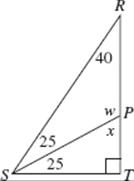
12. (64) Since the sum of the six angles is 360° (KEY FACT I3), combining like terms, we get 5x + 40 = 360 ![]() 5x = 320
5x = 320 ![]() x = 64.
x = 64.
13. (54) ![]() To find Henry’s average speed, in kilometers per hour, divide the distance he went, in kilometers (198), by the time it took, in hours. Henry drove for 3 hours and 40 minutes, which is
To find Henry’s average speed, in kilometers per hour, divide the distance he went, in kilometers (198), by the time it took, in hours. Henry drove for 3 hours and 40 minutes, which is ![]() hours (40 minutes =
hours (40 minutes = ![]() hour =
hour = ![]() hour). Henry’s average speed, in kilometers per hour, was
hour). Henry’s average speed, in kilometers per hour, was ![]()
14. (122) Write out the first few terms, being careful to follow the directions. The first term is 1. The second term is 1 less than 3 times the first term: 3(1) – 1 = 2. The third term is 1 less than 3 times the second term: 3(2) – 1 = 5. Continue: 3(5) – 1 = 14; 3(14) – 1 = 41; 3(41) – 1 = 122.
15. (36) Use TACTIC 6. Assume there are 100 stockholders and a total of 100 shares of stock. Then Group A has 10 members and Group B has 90. The 10 members of Group A own 80 shares, an average of 8 shares per member. The 90 members of Group B own the other 20 shares, an average of ![]() shares per member.
shares per member.
Then, 8 = ![]()
![]() k = 8
k = 8 ![]() = 36
= 36
16. (52) This is a weighted average (KEY FACT E6):
![]() =
= ![]() = 52
= 52
![]() **If you prefer, assume there are 100 marbles, 40 of which are red and 60 of which are blue:
**If you prefer, assume there are 100 marbles, 40 of which are red and 60 of which are blue:![]() =
= ![]() = 52
= 52
17. ![]() If there are x seats on each bus, then the group is using
If there are x seats on each bus, then the group is using ![]() (3x) =
(3x) = ![]() x seats. After
x seats. After ![]() of passengers get off,
of passengers get off, ![]() of them, or
of them, or ![]() remain. The fraction of the 2x seats now being used on the two buses is
remain. The fraction of the 2x seats now being used on the two buses is ![]()
**Again, you can use TACTIC 6 to avoid working with x. Assume there are 20 seats on each bus. At the beginning, the group is using 48 of the 60 seats on the three buses ![]() When 12 people left
When 12 people left ![]() the 36 remaining people used
the 36 remaining people used ![]() =
= ![]() of the 40 seats on two buses.
of the 40 seats on two buses.
18. (1) a–4 = 16 ![]()
![]() =
= ![]()
![]() 16a4 = 1.
16a4 = 1.
So, a4 = ![]()
![]() a =
a = ![]()

Section 8 Critical Reading
1. B. The subject’s verbosity, her tendency to use too many words, is what’s irritating. The second clause defines the first.
(Definition)
2. C. It would be useless or futile to try to poison pests chemically if the creatures eventually became resistant to or able to withstand the effect of each new poison you introduced.
Choice C is correct.
Remember: watch for signal words that link one part of the sentence to another. The conjunction for connecting the two halves of the sentence signals you to expect a cause and effect relationship between them.
(Cause and Effect Signal)
3. B. Because insect bodies are fragile or breakable, it is surprising that enough of them have survived (lasted in an unbroken condition) for scientists to draw conclusions about the way insect species changed over time.
The key word here is “remarkable.” It signals a built-in contrast between what one might expect to have happened and what actually did happen.
(Implicit Contrast Signal)
4. C. There are two key words here, “unfortunately” and “imitations.” “Unfortunately” indicates that the missing word has negative connotations: the plays currently showing on Broadway are pretty poor. “Imitations” defines in just what way these plays are poor.
They are copies of hit plays, imitations trying to follow a once-sucessful formula or pattern that no longer works. In other words, they are formulaic fare.
(Definition)
5. D. Callas longed for honest criticism. She had grown tired of adulation (praise) because she had been surrounded by a group of people who constantly extolled (praised) her singing.
(A retinue of sycophants is a group of flatterers in attendance on an important personage.)
Remember, before you look at the choices, to read the sentence and think of a word that makes sense.
Likely Words: praised, admired.
(Examples)
6. A. Moore’s criticism was not unsure (tentative) or provisional. It was sure or confident: she wrote confidently.
Remember to watch for signal words that link one part of the sentence to another. The presence of or linking a pair or a series of items indicates that the missing word may be a synonym or near-synonym for “provisional,” the other linked word.
This sentence contrasts two ideas without using a signal word. The contrast is implicit in the juxtaposition of the two clauses.
(Contrast Pattern)
7. C. Passage 1 states: “Dolphins left the land when mammalian brains were still small and primitive” (lines 27–29). This indicates that dolphins were once land animals, mammals like ourselves, whose evolutionary development took them back into the sea.
8. E. The passage indicates that human beings think of intelligence in terms of our own ability to manipulate our environment—our ability to build and do all sorts of things with our hands. Since dolphins have no hands, we have trouble appreciating their high level of intelligence because of our inclination to judge other life by our own.
9. D. Passage 1 attempts to reassess the nature and extent of dolphin intelligence, first giving reasons why human beings may have trouble appreciating how intelligent dolphins really are and then, in the concluding sentence, reflecting how dolphin intelligence (that looks “inward to the sea’s heart”) may complement human intelligence (that looks “outward on eternity”).
10. C. The dolphin’s acute echo-sounding sense is a sharp, keen sense that enables the dolphin to sound or measure the ocean depths by using echoes.
11. C. The entire passage has concentrated on the dolphin’s brain, so it is safe to assume that this is what is meant by “impressively elaborated instrument.” The items listed in the other answer choices have not been mentioned. Note that Choice B, an artificial range-finding device, is incorrect because the dolphin’s range-finding ability is entirely natural, not artificial.
12. A. The sea’s heart is like the human mind in that it swarms or teems (abounds) with grotesque or exotic forms of life.
13. C. The author’s tone is distinctly admiring. The passage speaks of the dolphins’ “remarkable range-finding ability,” mentions their care for each other, and repeatedly praises dolphin intelligence.
14. E. The quotation marks here indicate that the word in quotes is being used in a special sense (often an ironic one). In this case, as the next paragraph makes abundantly clear, the author is critical of both the results and the influence of Lilly’s experiments. He has some doubts as to how scientific those experiments were.
15. A. According to the author of Passage 2, by claiming that “dolphins communicate not only with one another but also with humans, mimicking human speech and reaching out across the boundaries that divide us” (lines 69–72), Lilly and his associates have overstated their case, misrepresenting the extent of dolphin intelligence.
Choice B is incorrect. In stating that Lilly’s conclusions have not withstood (stood up against) critical scrutiny, the author indicates that they have been critically scrutinized to an appropriate degree.
16. D. “Begging the question” refers to assuming the truth of the very point whose truth or falsehood you’re trying to establish. The author of Passage 2 considers the reasoning in this argument flawed; he views it with doubt or skepticism.
17. A. Proof that dolphins are far superior in linguistic capability to seals and other mammals clearly would contradict the results of the studies the author cites and would thus undercut or weaken their impact.
18. A. In its glorification of dolphin intelligence as something that equals or possibly exceeds human intelligence, the author of Passage 2 would find Passage 1 typical of the attitudes of Lilly and his associates.
19. A. Passage 1 is filled with images. The sea is a “wavering green fairyland.” The dolphin’s brain is an “impressively elaborated instrument.” Mammals take “a divergent road.” The passage concludes with an elaborate simile. It is clearly more figurative than Passage 2.
Choice B is incorrect. With its enigmatic references to some “impressively elaborated instrument” and to a “great eye” staring at eternity, Passage 1 is far more obscure than Passage 2.
Choice C is incorrect. Passage 1 is heavily slanted in favor of the superiority of dolphin intelligence. It is not more objective or impartial than Passage 2, which attempts to give a short survey of research on dolphin intelligence, summing up current experiments and providing historical background.
Choice D is incorrect. The italicized introduction indicates that Passage 2 was written almost thirty years after Passage 1. By definition, it presents a more current, up-to-date view of the topic. Always pay attention to information contained in the introductions to the reading passages.
Choice E is incorrect. Passage 1’s conclusion is sheer conjecture orspeculation.
Section 9 Mathematical Reasoning
1. B. ![]() 88 beeps ÷ 16 beeps per minute = 5.5 minutes. If you prefer, set up a ratio and cross-multiply:
88 beeps ÷ 16 beeps per minute = 5.5 minutes. If you prefer, set up a ratio and cross-multiply: ![]() =
= ![]()
2. E. ![]()
![]() means
means ![]() (or 0.5) divided by 100, which equals 0.005. With your calculator verify that choices A through D all equal 0.005, or
(or 0.5) divided by 100, which equals 0.005. With your calculator verify that choices A through D all equal 0.005, or ![]() %, whereas choice E,
%, whereas choice E, ![]()
3. B. {[(a × a) + a] ÷ a} – a =
{[a2 + a] ÷ a} – a =![]() – a = a + 1 – a = 1.
– a = a + 1 – a = 1.
**Use TACTIC 6. Let a = 2; then {[(2 × 2) + 2] ÷ 2} – 2 = {[4 + 2] ÷ 2} – 2 = {6 ÷ 2} – 2 = 3 – 2 = 1.
4. B. There is only 1 prime divisible by 7, namely, 7.
5. C. The sum of the measures of the four angles of any quadrilateral is 360° (KEY FACT K1). If the average of the measures of two of them is 60°, then they total 120° (TACTIC E1), leaving 240° for the other two angles, so their average is 120°.
**Draw a quadrilateral, two of whose angles measure 60°, and estimate the measures of the other angles. None of the wrong choices is even close.

6. D. Just check each choice. Is there a triangle whose sides are 1, 2, 3? No, the sum of any two sides of a triangle must be greater than the third side (KEY FACT J12). (I is false.)
Are there triangles whose sides are 10, 11, 12 and 100, 101, 102? Yes. (II and III are true.) Statements II and III only are true.
7. C. By KEY FACT M4, the diagonal of a box whose dimensions are ![]() , w, h is
, w, h is ![]() . Here,
. Here, ![]() = w = h = 3, so AB =
= w = h = 3, so AB = ![]() =
= ![]() = 3
= 3 ![]() .
.
**If you get stuck on a question like this, use TACTIC 8: eliminate absurd choices and guess. Since each edge is 3, clearly AB > 3, and going around the edges from A to B would give you 9, which is clearly too big. Then, at the very least, eliminate choices A and E.
8. B. If you know the formula for an arithmetic sequence (KEY FACT P2), you can use it with a20 = 63 and d = 5. 63 = a20 = a1 + 19(5) ![]() 63 = a1 + 95, and so a1 = –32. Since the first term is –32, the 2nd term is –32 + 5 = –27.
63 = a1 + 95, and so a1 = –32. Since the first term is –32, the 2nd term is –32 + 5 = –27.
**To get from the 2nd term to the 20th term, you need to add the common difference (5) 18 times. a2 + 18(5) = 63 ![]() a2 + 90 = 63
a2 + 90 = 63 ![]() a2 = –27.
a2 = –27.
9. D. Draw a diagram. The minute hand, of course, is pointing right at 4. The hour hand, however, is not pointing at 11. It was pointing at 11 at 11:00, 20 minutes, or ![]() hour, ago. The hour hand is now one-third of the way between 11 and 12, so there are 20 degrees between the hour hand and 12 and another 120 degrees to 4, a total of 140 degrees.
hour, ago. The hour hand is now one-third of the way between 11 and 12, so there are 20 degrees between the hour hand and 12 and another 120 degrees to 4, a total of 140 degrees.
**If you can’t figure the answer out exactly, guess. From the diagram, you should see that the angle is considerably more than 120.
Eliminate at least A and B, and probably see that E is too big.
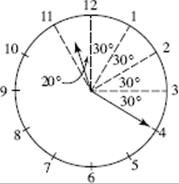
10. E. ![]() Calculate each 2010 salary by multiplying each 2000 salary by (1 + the percent change).
Calculate each 2010 salary by multiplying each 2000 salary by (1 + the percent change).
Eve had the highest 2010 salary, $42,000(1.06) = $44,520.
11. B. ![]() Use TACTIC 6: substitute a simple number for x. Since this is a percent problem, choose 10 or 100. Let x = 10: 10% less than 10 is 9, and 10% more than 9 is 9.9. Now, what percent of 100 (10x) is 9.9? The answer is 9.9%.
Use TACTIC 6: substitute a simple number for x. Since this is a percent problem, choose 10 or 100. Let x = 10: 10% less than 10 is 9, and 10% more than 9 is 9.9. Now, what percent of 100 (10x) is 9.9? The answer is 9.9%.
12. E. 2 – 3 ![]() = 8
= 8 ![]() – 3
– 3 ![]() = 6
= 6 ![]()
![]() = –2. Since the square root of a number can never be negative, there is no value of x that satisfies the equation .
= –2. Since the square root of a number can never be negative, there is no value of x that satisfies the equation .
** ![]() , and hence 3
, and hence 3 ![]() , must be positive, and subtracting a positive number from 2 cannot yield 8.
, must be positive, and subtracting a positive number from 2 cannot yield 8.
![]() **Use TACTIC 5: backsolve. Test choices A through D. None of them works.
**Use TACTIC 5: backsolve. Test choices A through D. None of them works.
13. A. Factor each numerator and denominator and simplify.
![]()
![]()
**Use TACTIC 6: plug in a simple number for x, say 2. Then.
![]()
Only choice A equals 1 when x = 2.
14. E. g(4)=f(4·4)=f(16)=162+![]() = 256 + 4 = 260
= 256 + 4 = 260
15. C. Assume Adam loses the minimum number, one-third, of the remaining games. Say he loses x games and wins 2x games. Then, in total, he will have 6 + 2x wins and 24 + x losses. Finally,
6 + 2x > 24 + x ![]() 2x > 18 + x
2x > 18 + x ![]() x > 18 and so x is at least 19. He has at least 19 additional losses and 38 additional wins, for a total of 57 more games.
x > 18 and so x is at least 19. He has at least 19 additional losses and 38 additional wins, for a total of 57 more games.
**Avoid the algebra and zoom in by trial and error. If Adam plays 30 more games, losing 10 and winning 20, he’ll have 34 losses and 26 wins—not enough. If he plays 60 more games, losing 20 and winning 40, he’ll have 46 wins and 44 losses. Close enough, pick 57.
16. A. The graph on the bottom is the result of shifting the graph on the top 3 units to the left. Therefore, by KEY FACT R2, its equation is f (x + 3).
Section 10 Writing Skills
1. E. Wordiness. Choice E omits the unnecessary words without committing fresh errors.
2. D. Unnatural construction. The subject of the sentence is Dr. Seuss; the underlined portion should be modified to refer directly to Seuss.
Choice D does so, replacing the original construction with a subordinate clause.
3. C. Error in usage. Do not use when after is in making a definition.
4. C. Adjective-adverb confusion. Change notorious optimistic to notoriously optimistic.
5. A. Sentence is correct.
6. E. Lack of conciseness. The original sentence is unnecessarily wordy. Choice E cuts out the needless words and substitutes an active verb for the linking verb is.
7. E. Wordiness and error in usage. Incredulous means disbelieving; only people can be incredulous (“When Shelby heard that she had scored a perfect 2400 on the SAT, she was momentarily incredulous; then she was ecstatic.”) The series of accidents was incredible (unbelievable), not incredulous. Choice E avoids this usage error and eliminates unnecessary words.
8. A. Sentence is correct.
9. E. Errors in subject-verb agreement. The suject is increase (singular); the verb should be singular as well. Replace have encouraged with has encouraged.
10. B. Lack of parallelism. Replace as well as with and.
11. D. Lack of parallelism. The use of “not only but also” indicates a need for parallel structure. In Choice D, revitalize the social security system exactly parallels create a universal health care system.
12. D. Error in pronoun choice. Avoid shifting from one pronoun to another within a single sentence. Change you can learn to one can learn.
13. B. Dangling participial phrase. Who was brought up in an all-white suburb? I was. Choice B corrects the dangling participial phrase by rearranging the sentence so that “Brought … suburb” clearly refers to the pronoun “I.”
14. A. Sentence is correct.